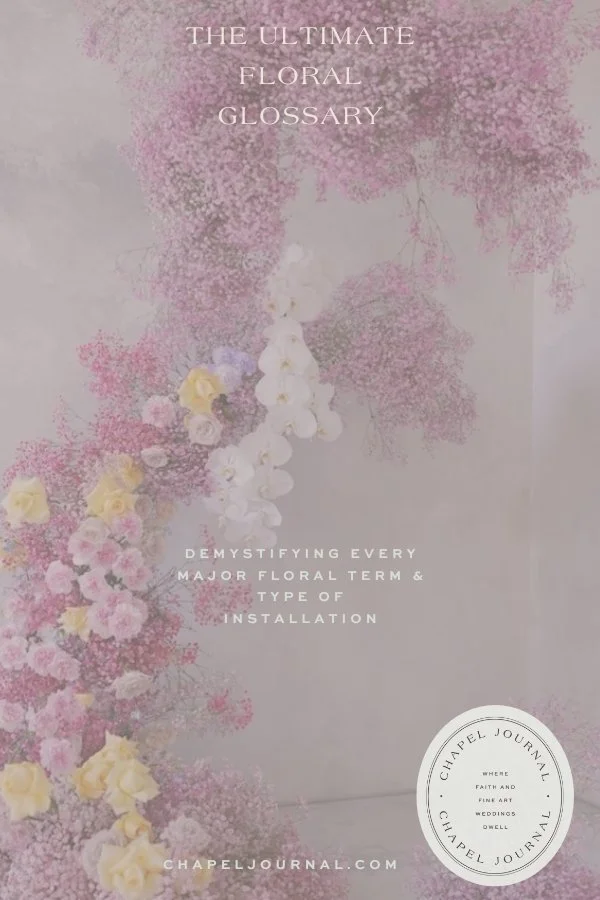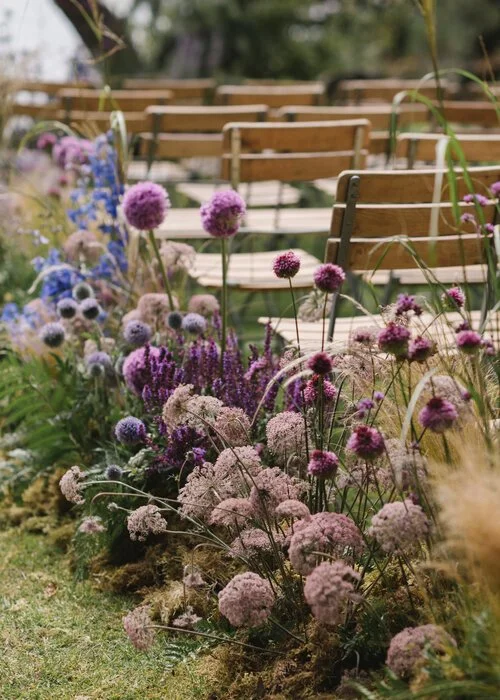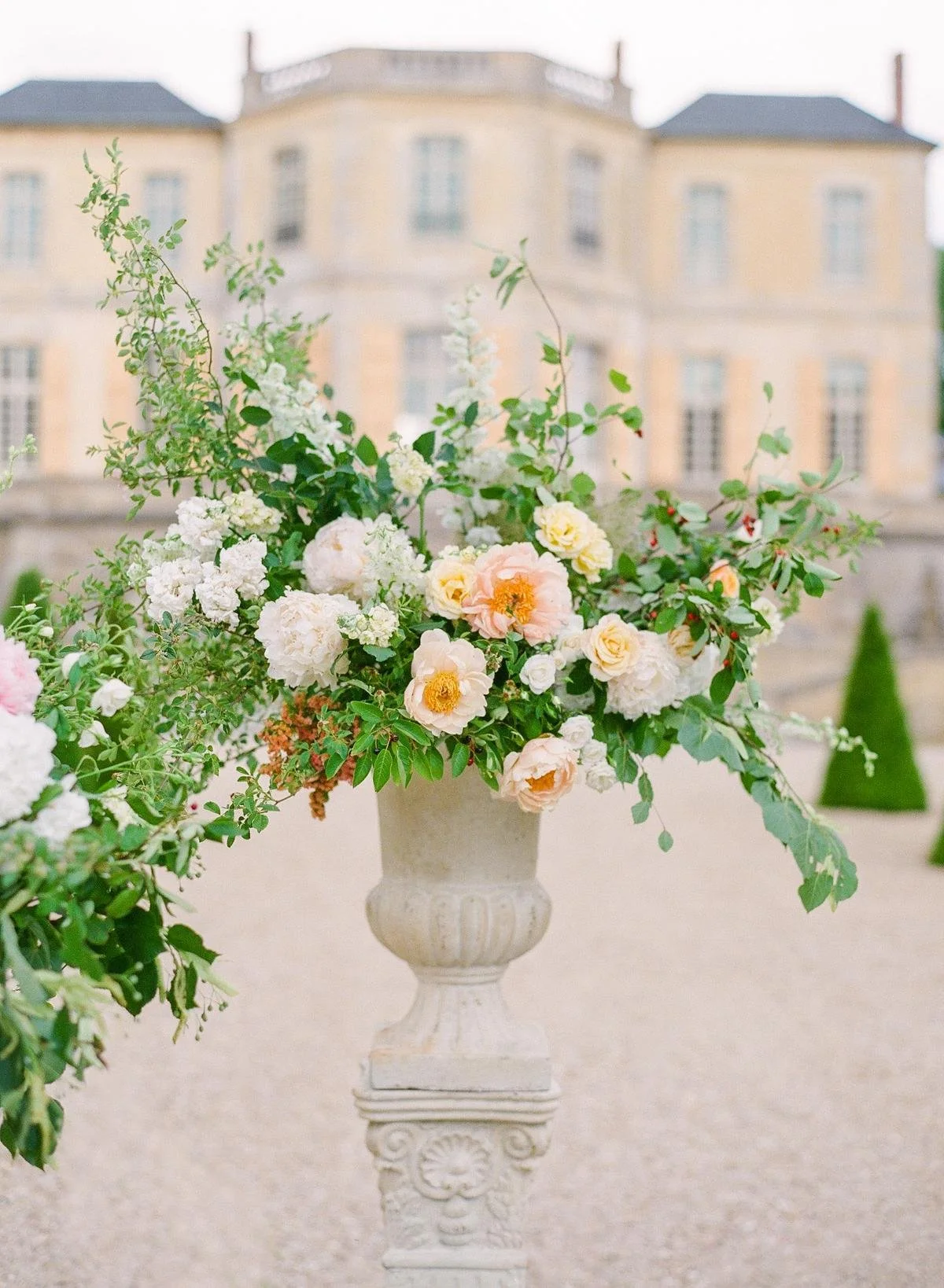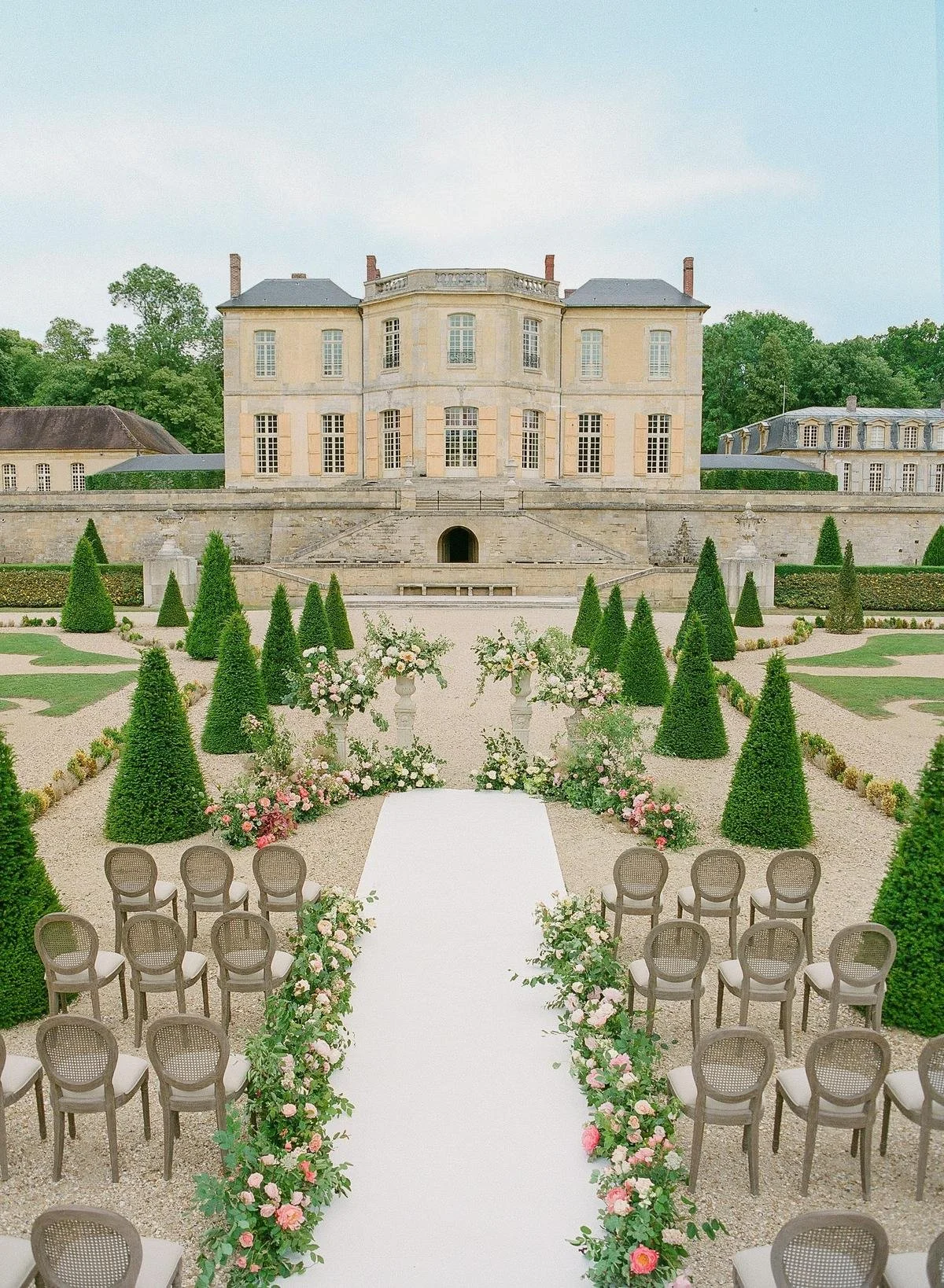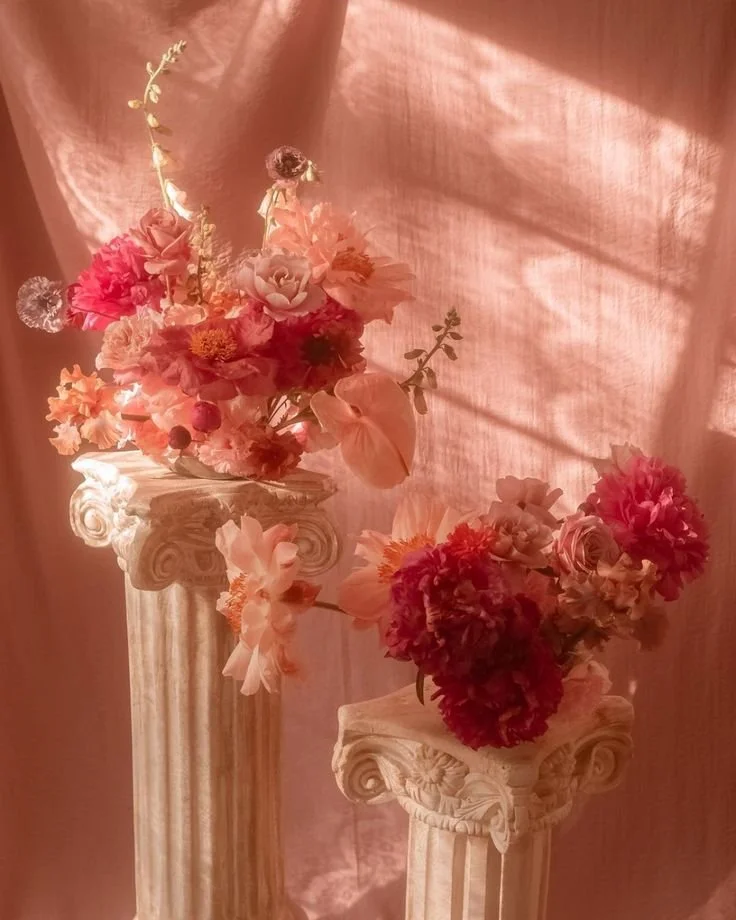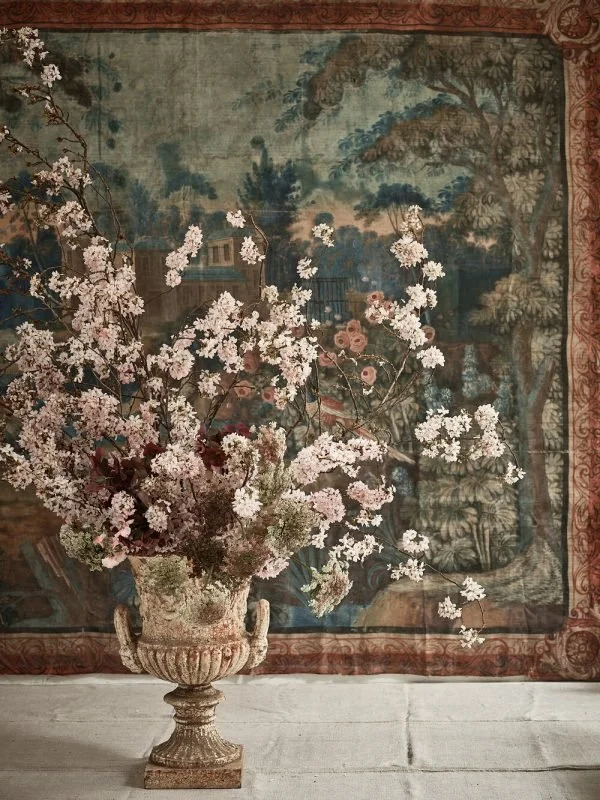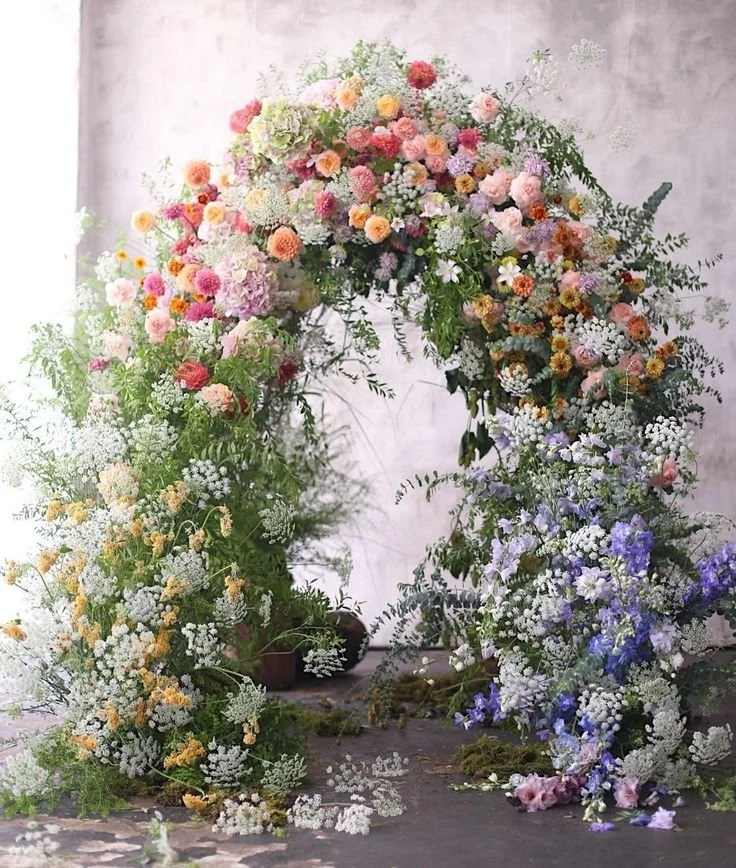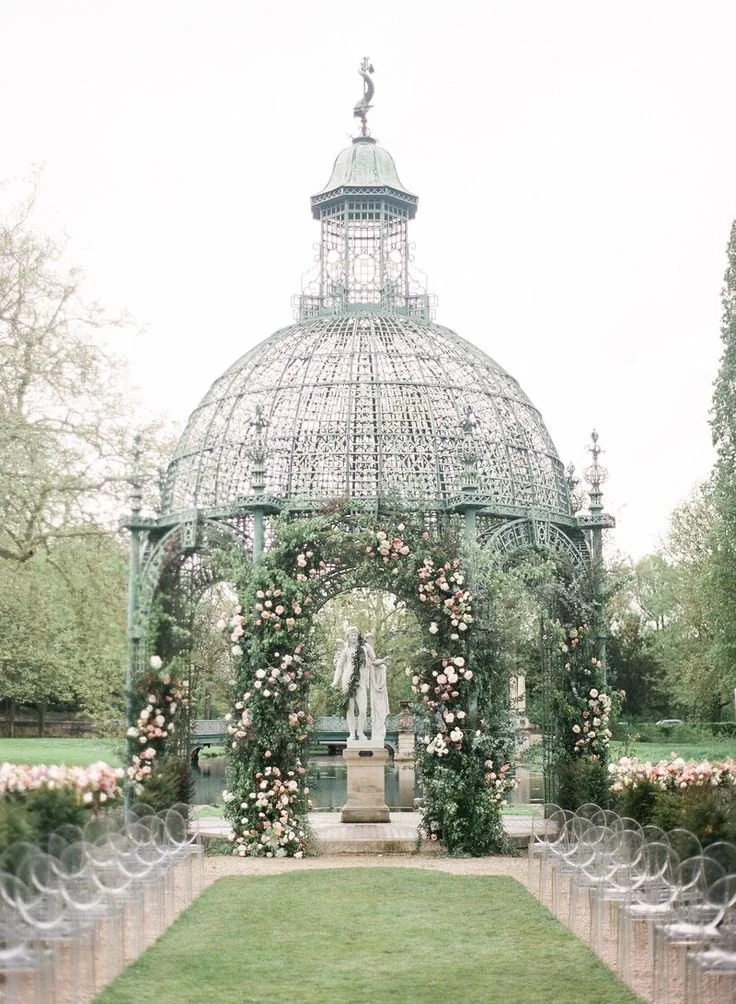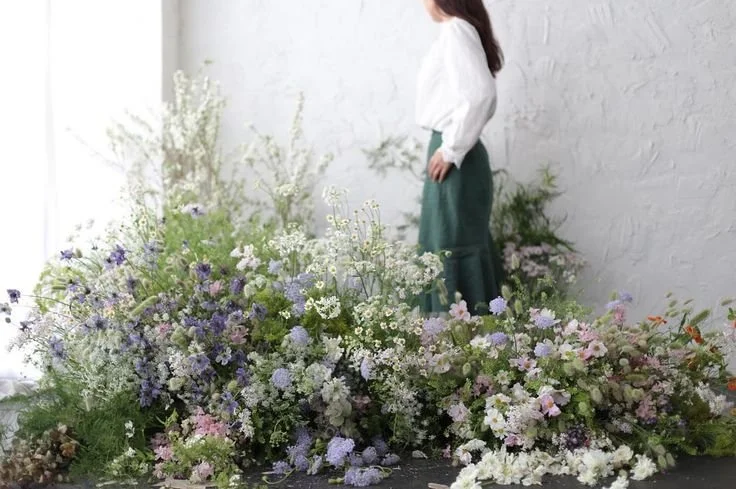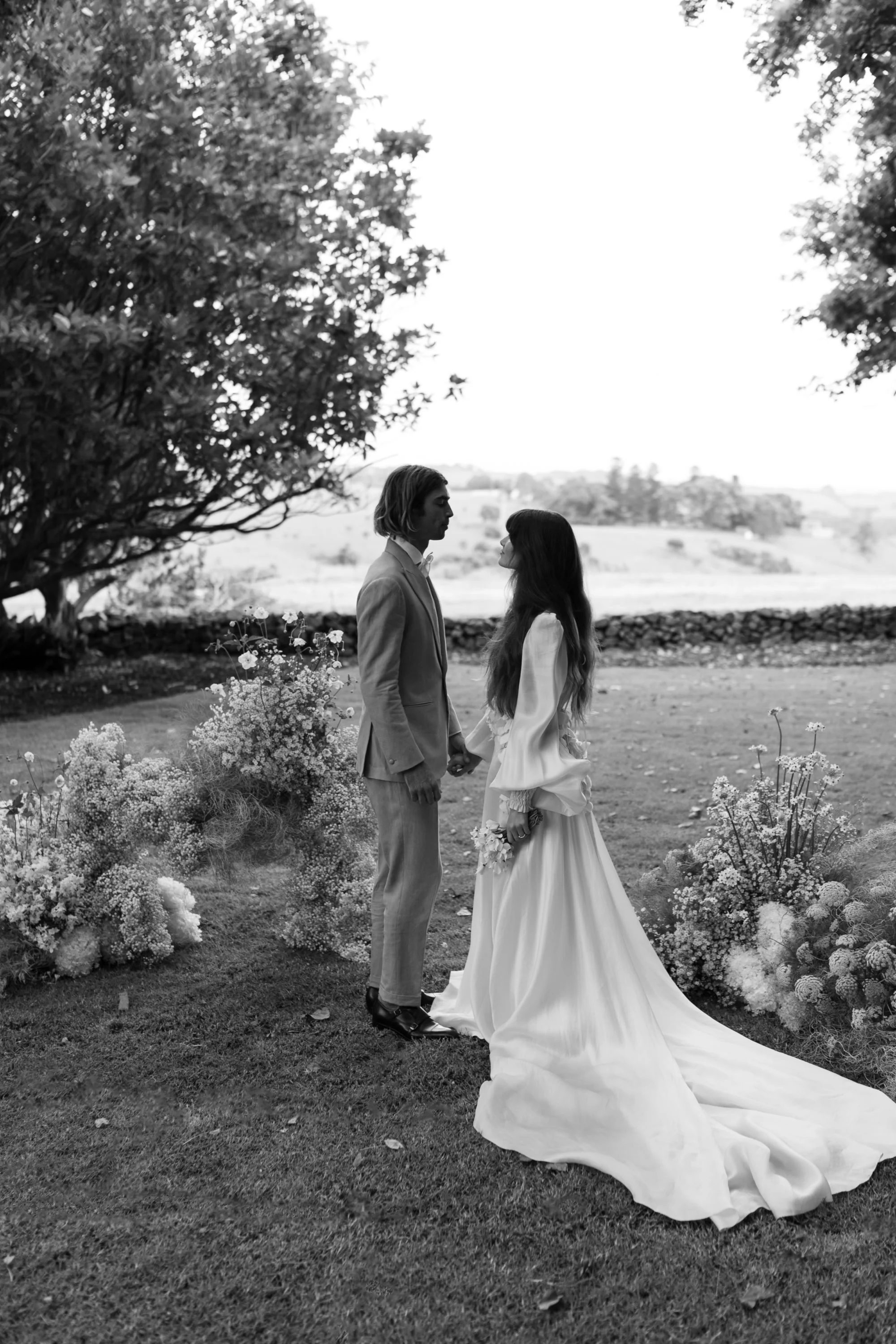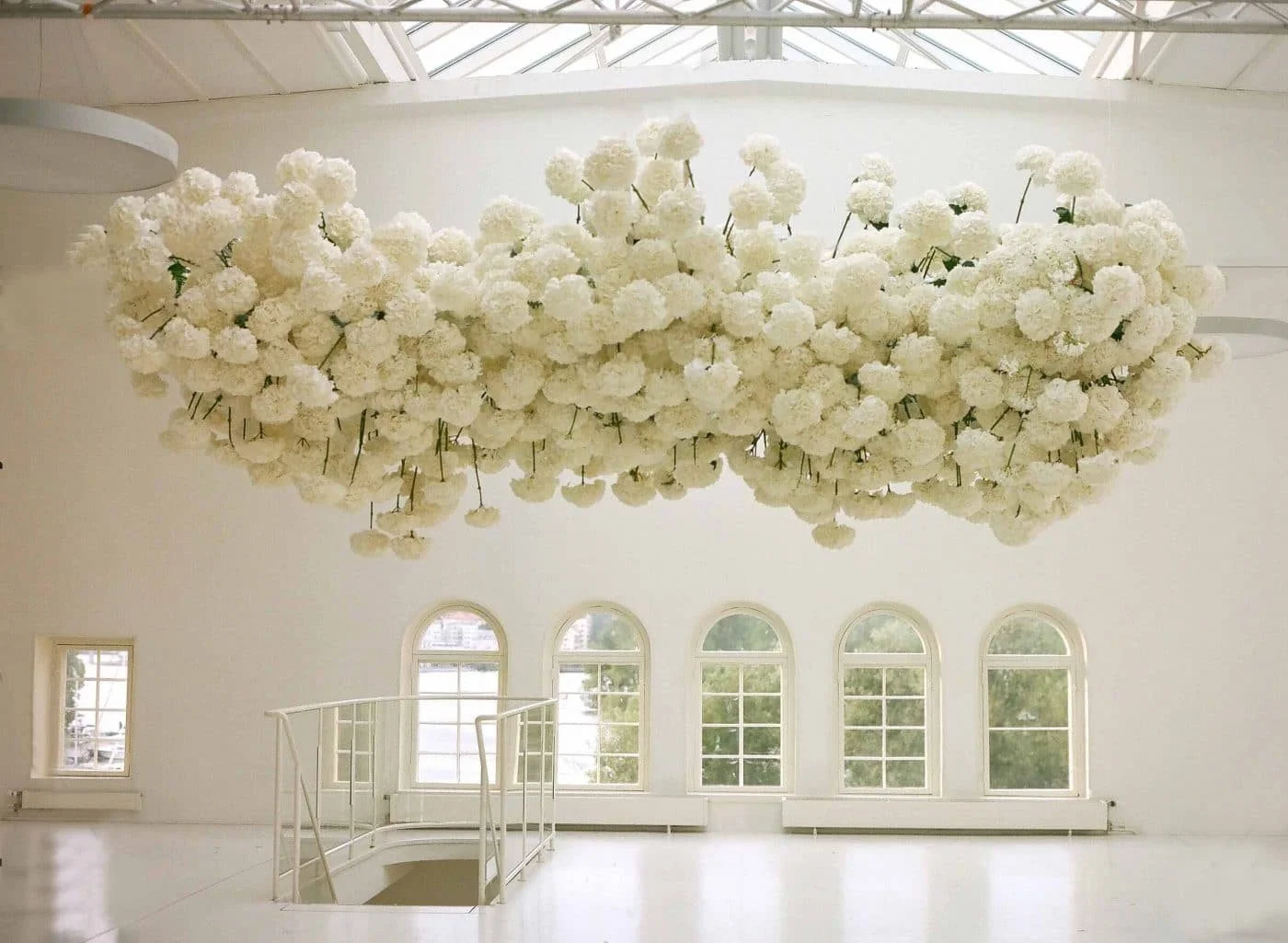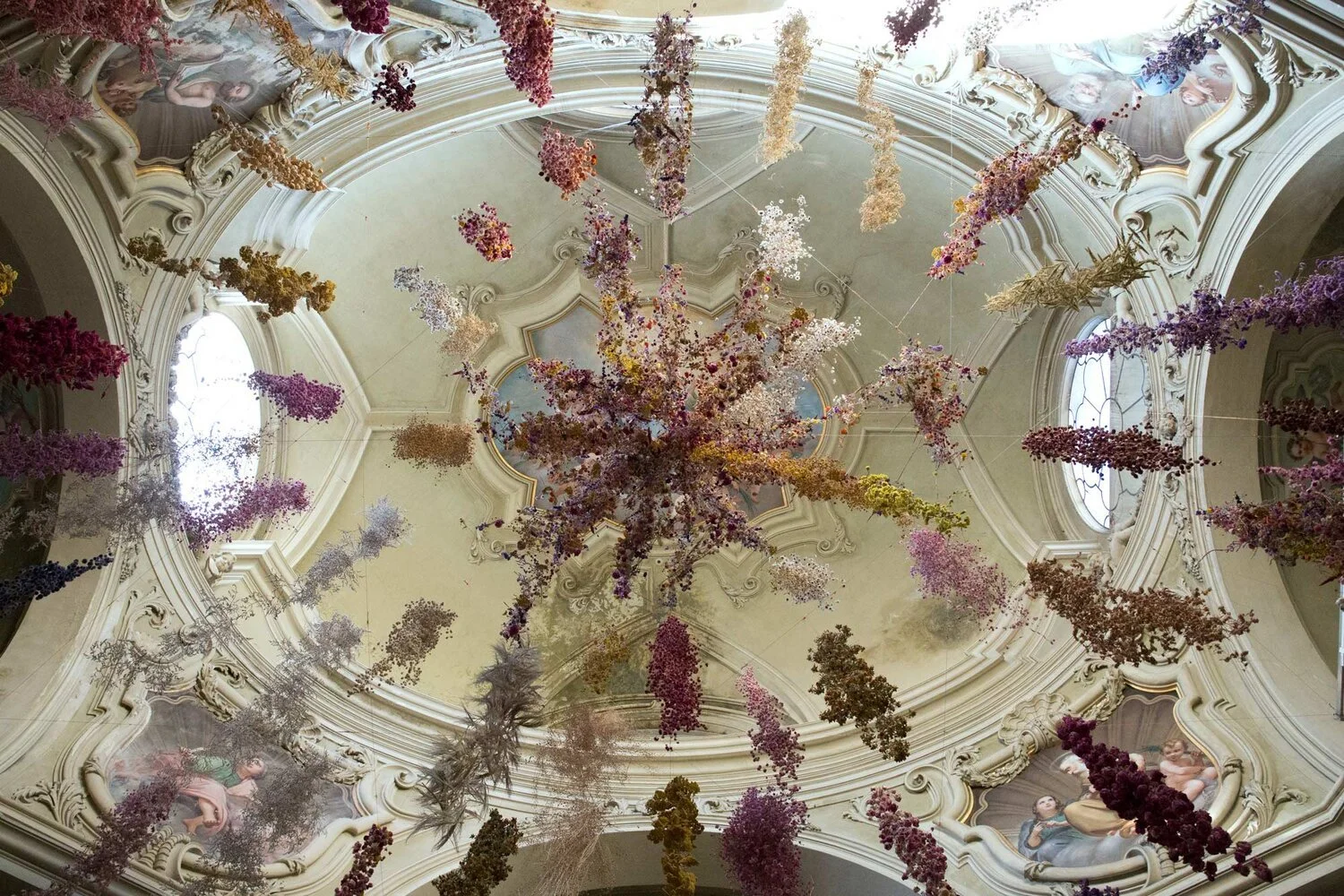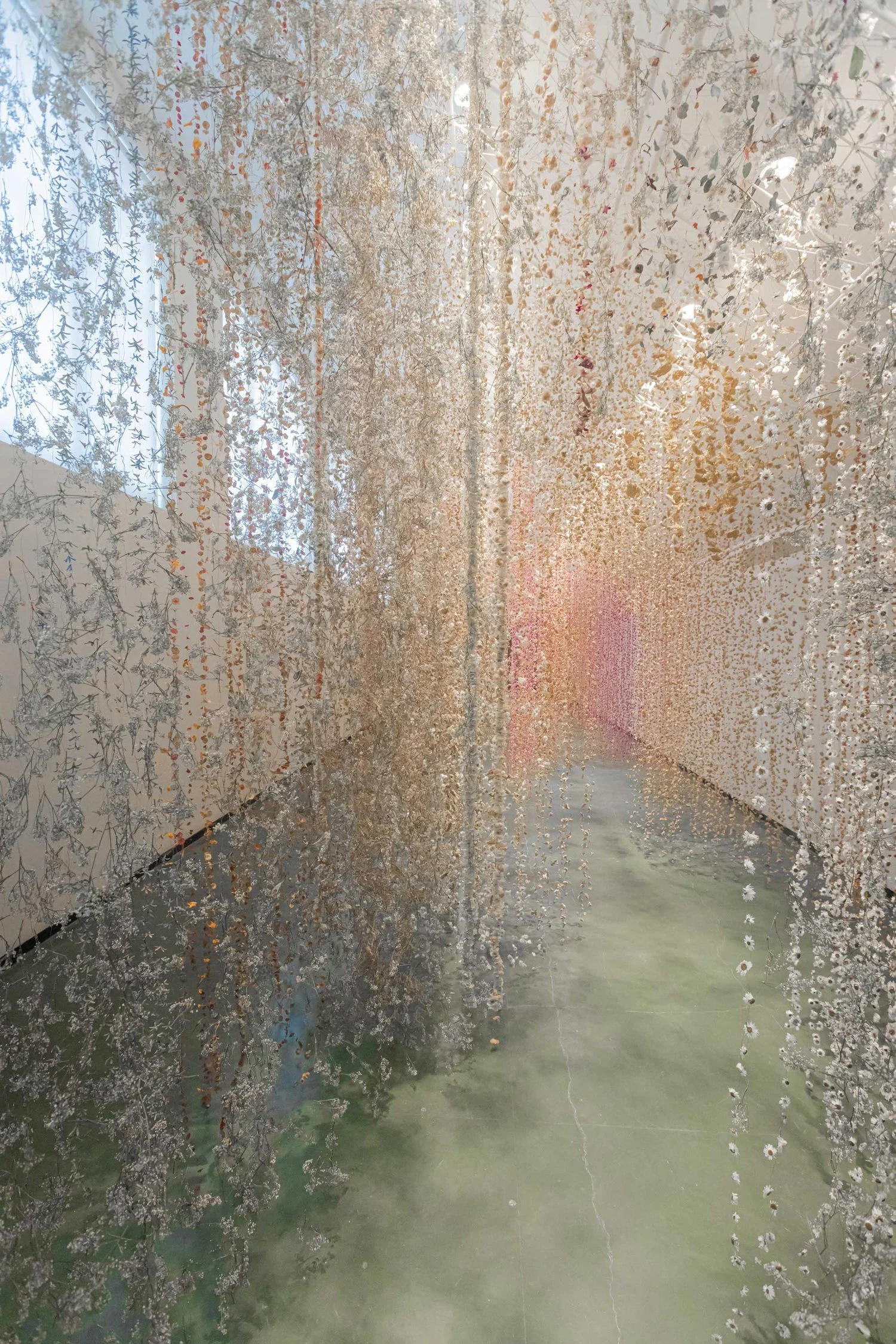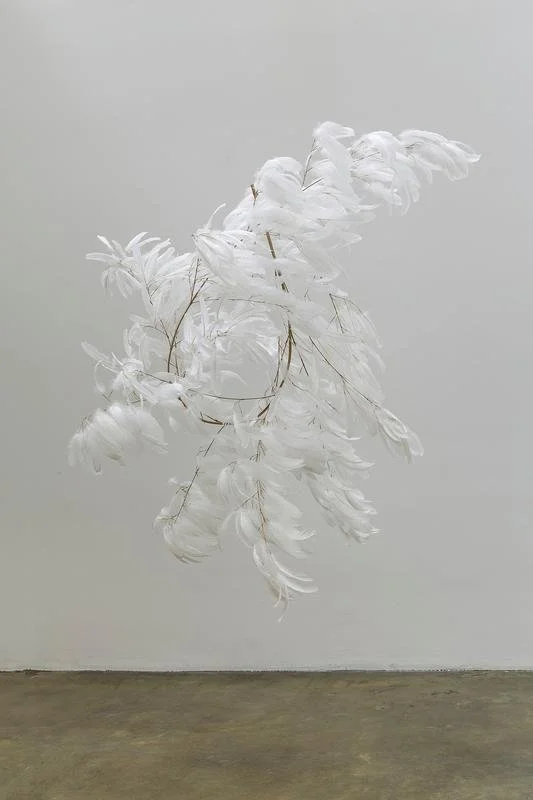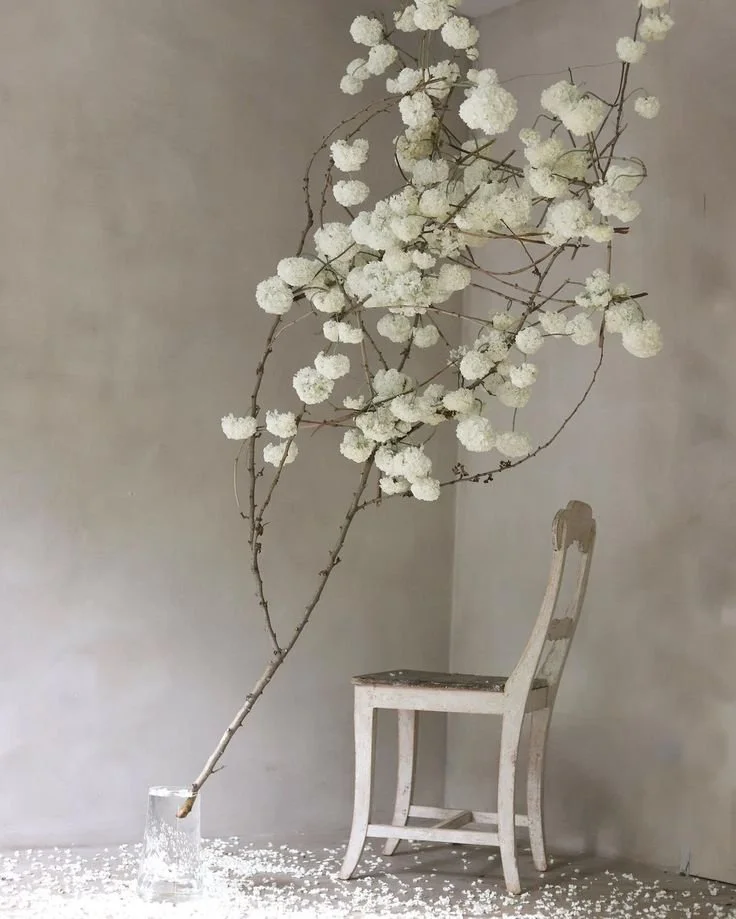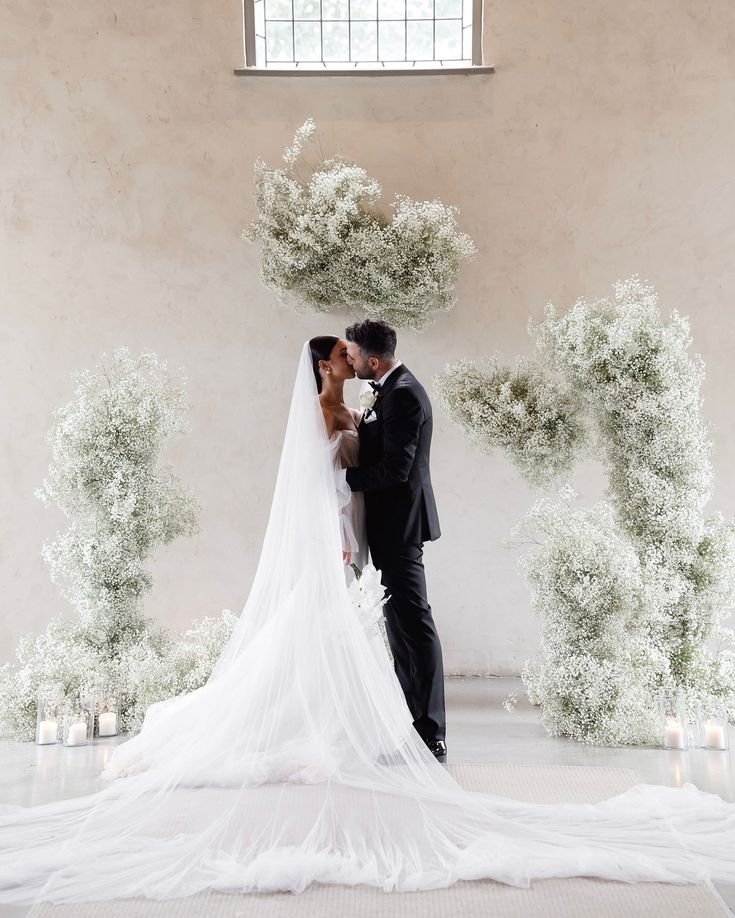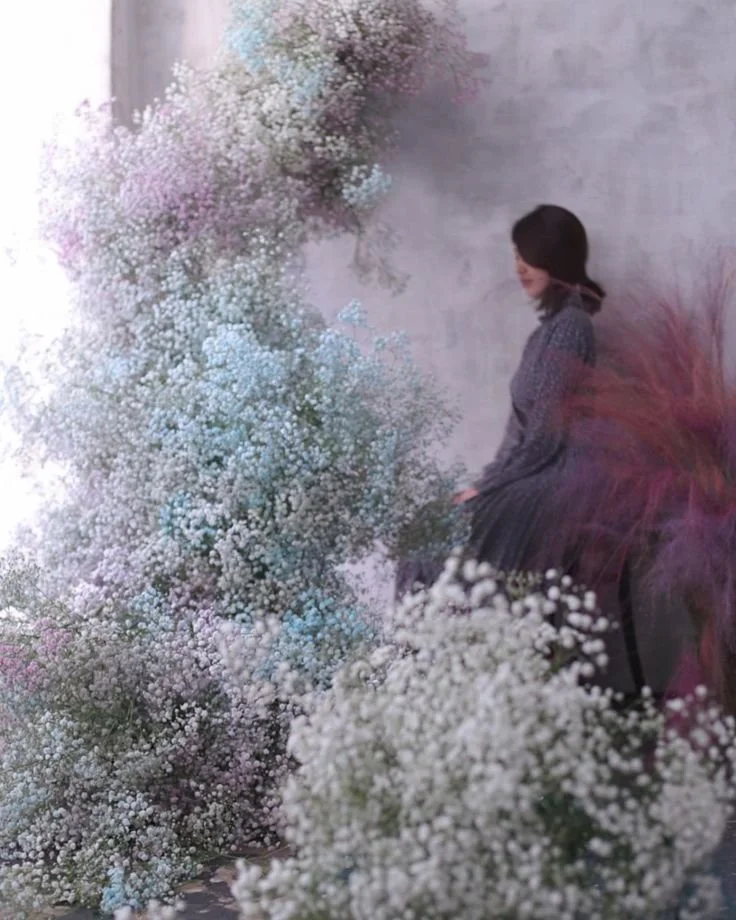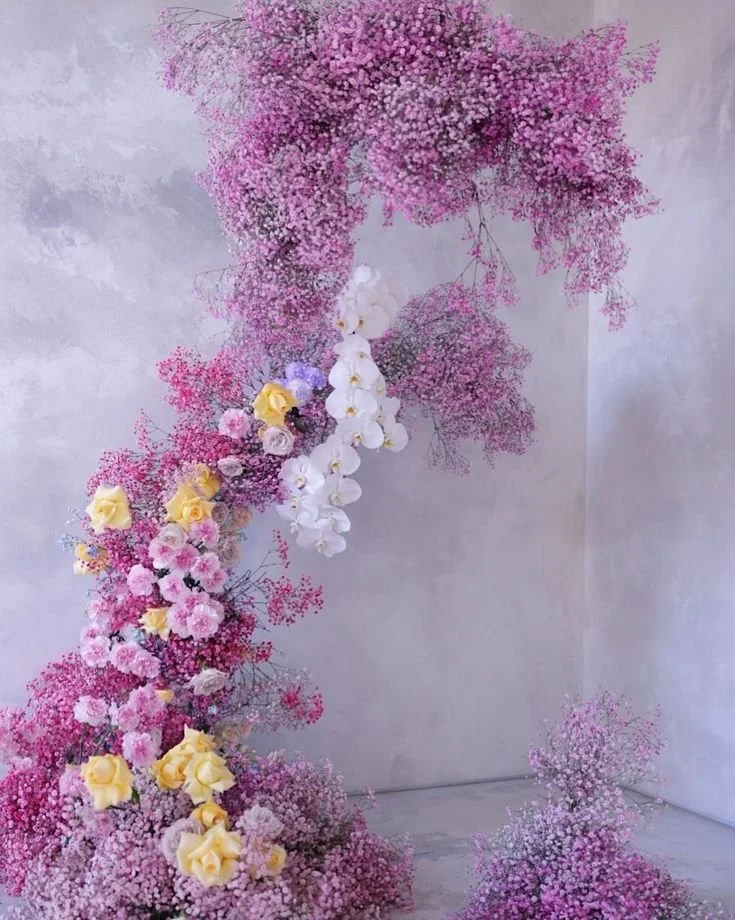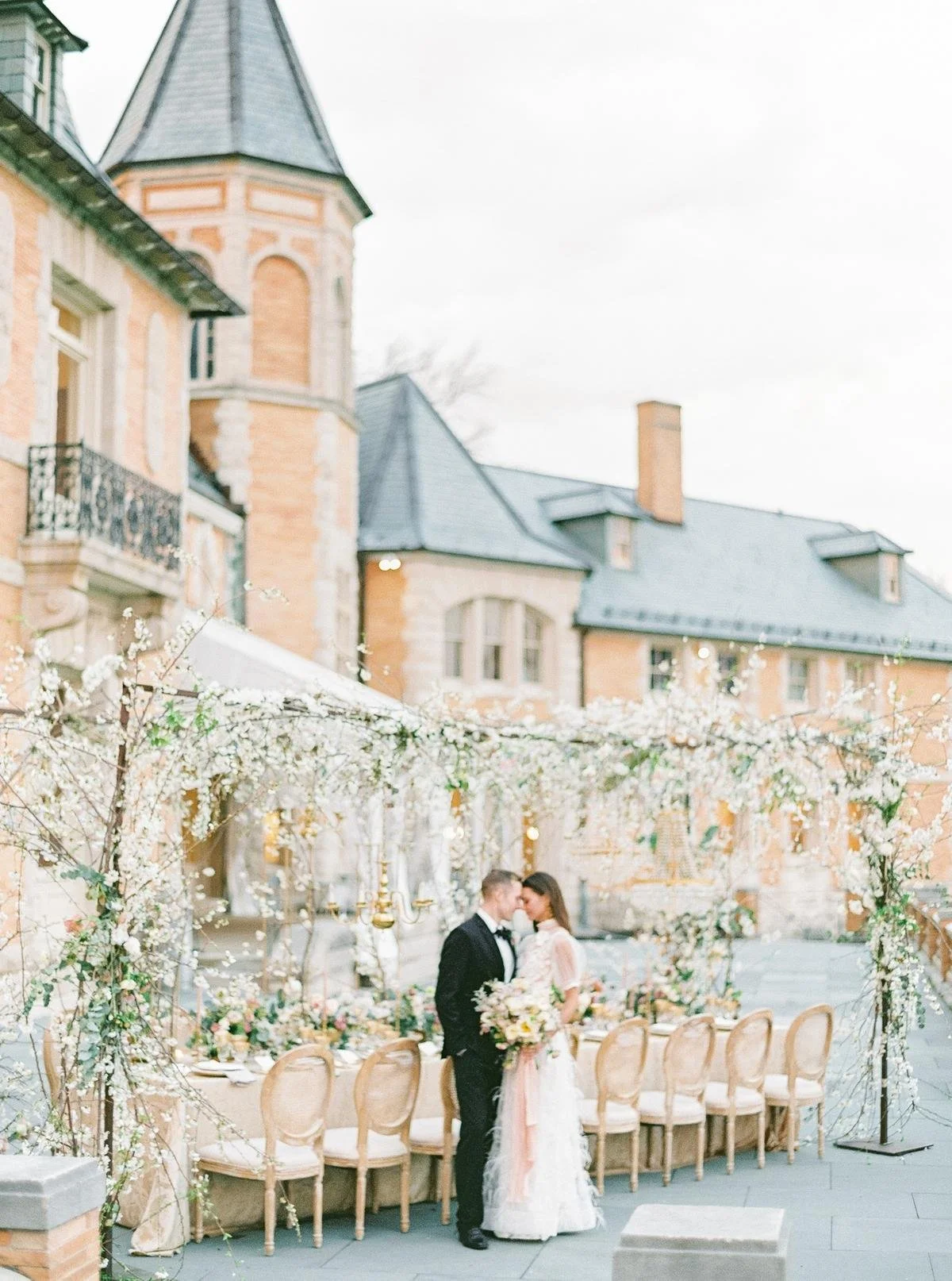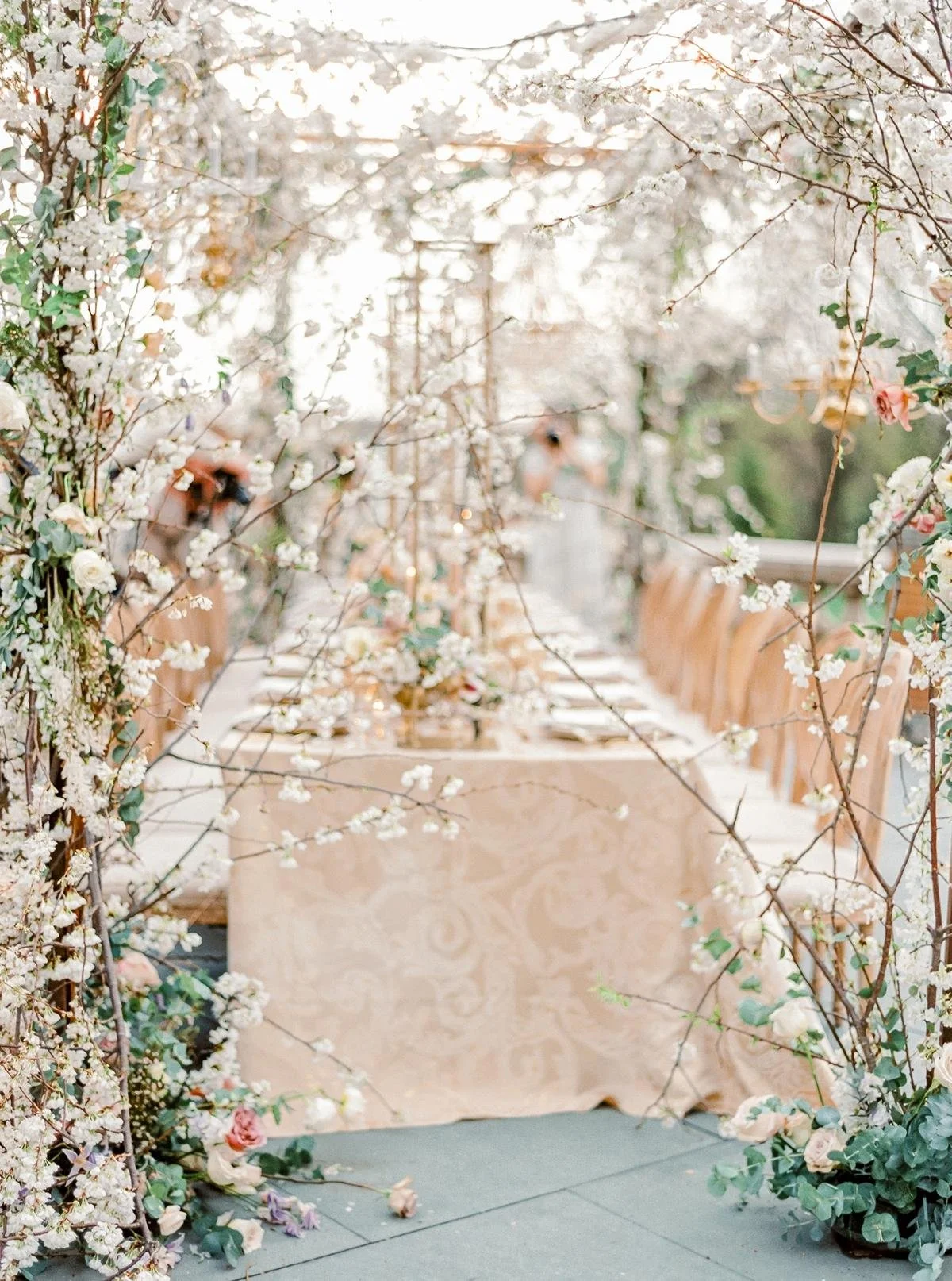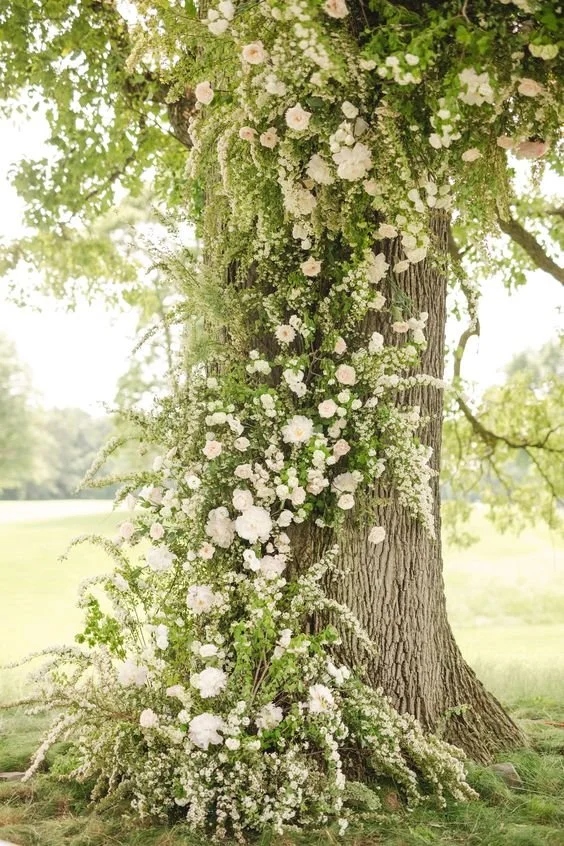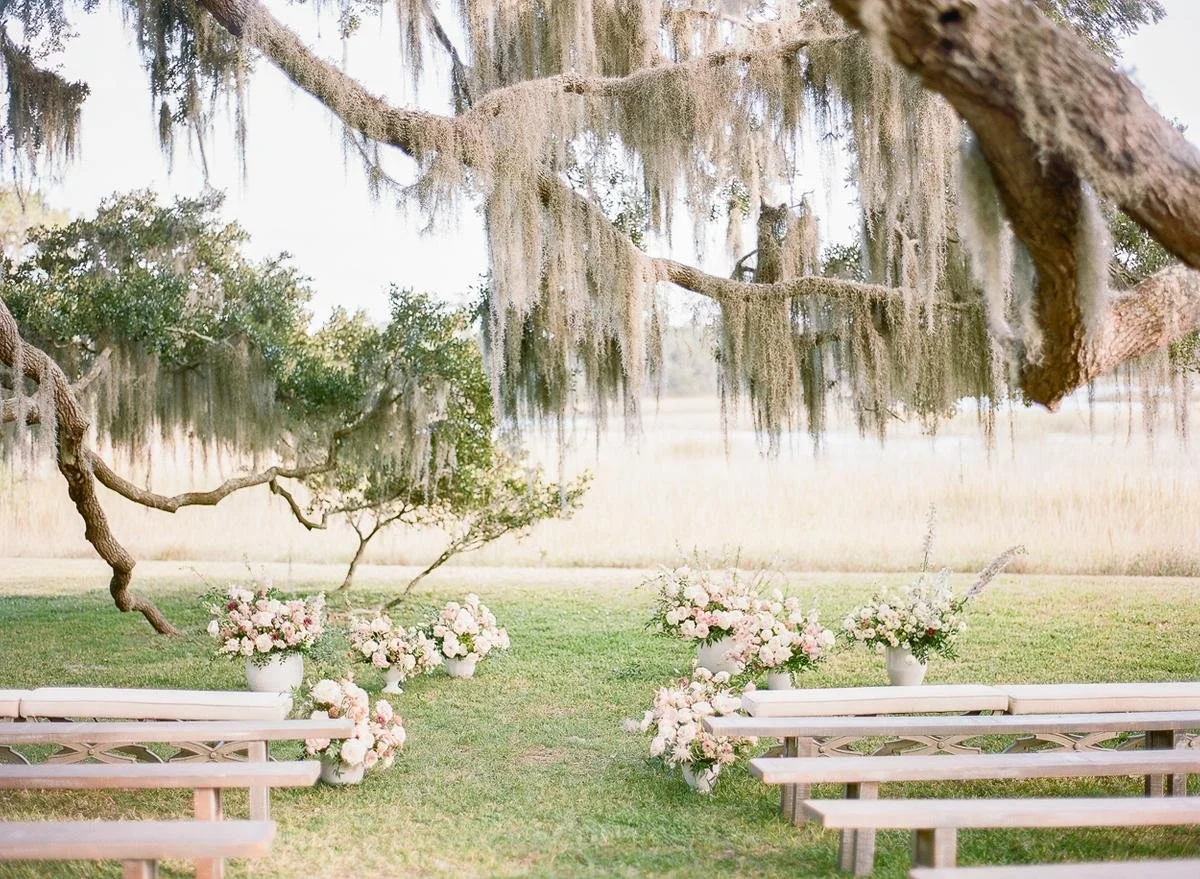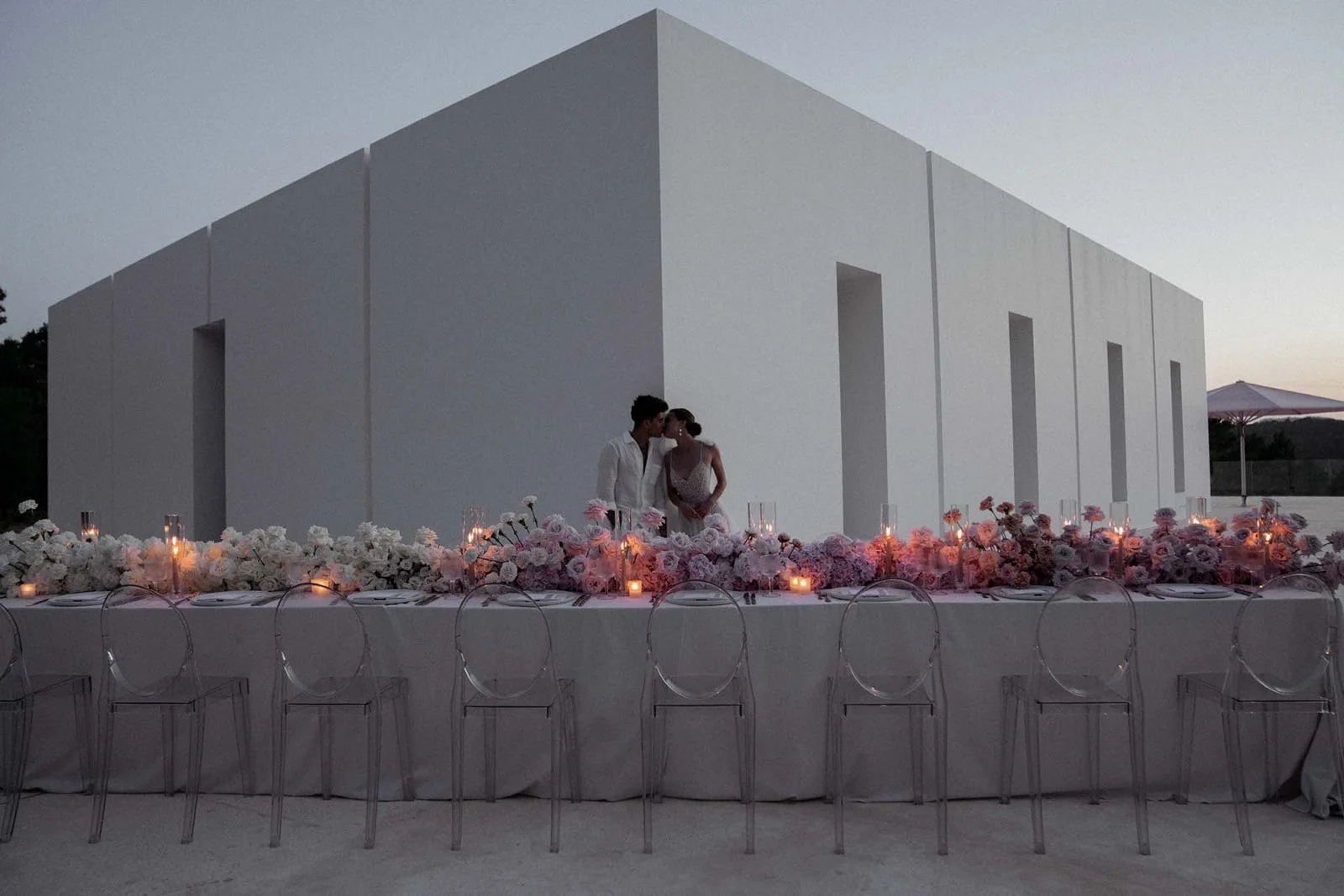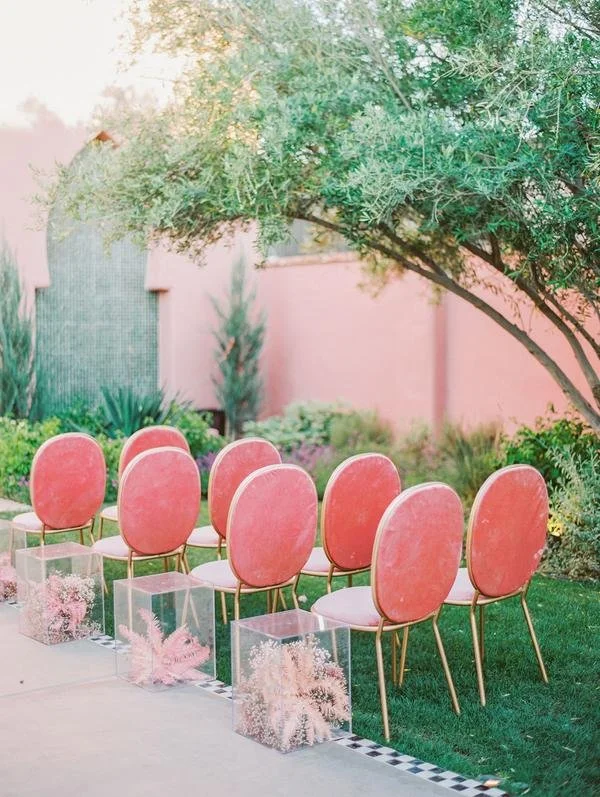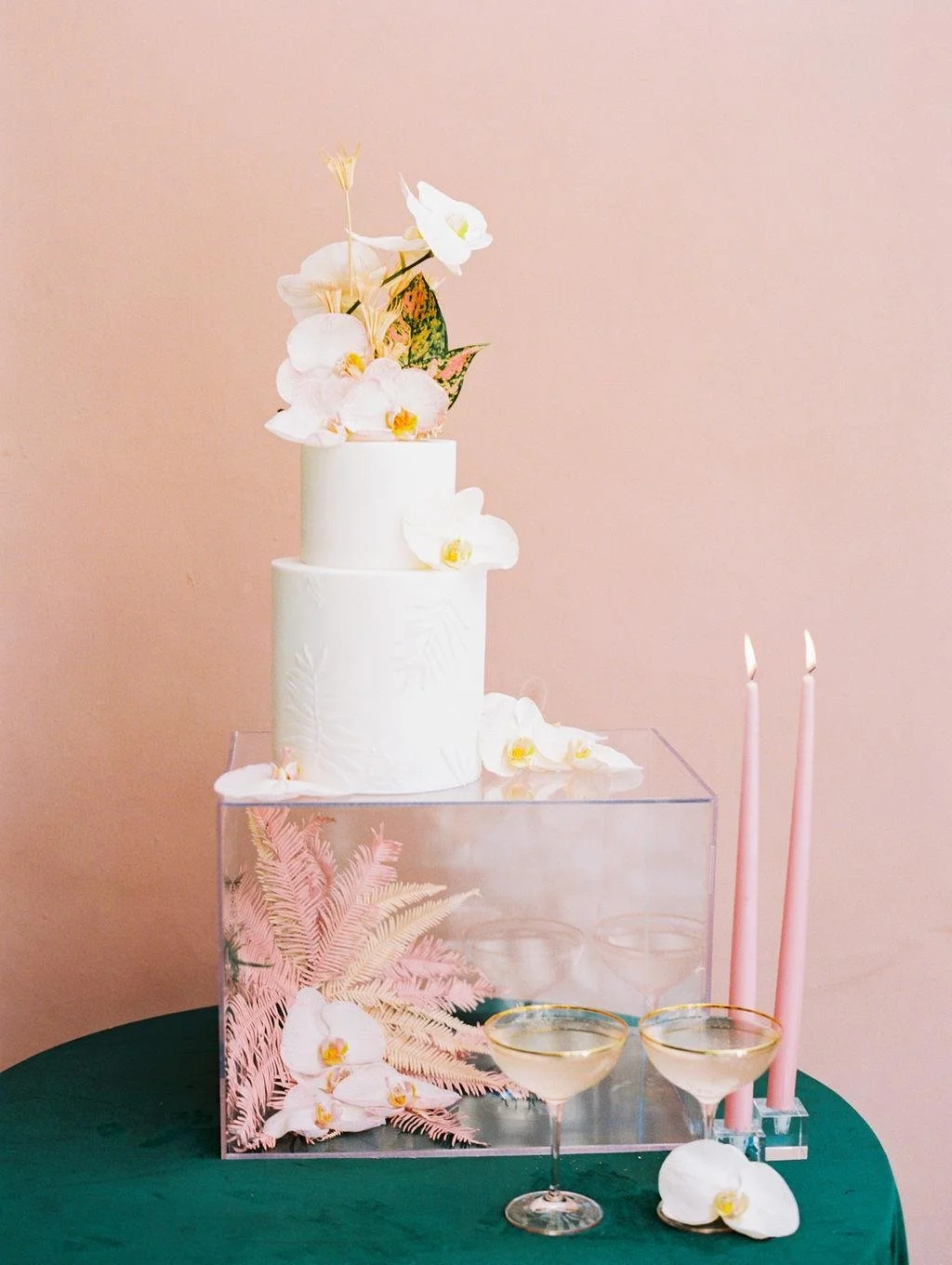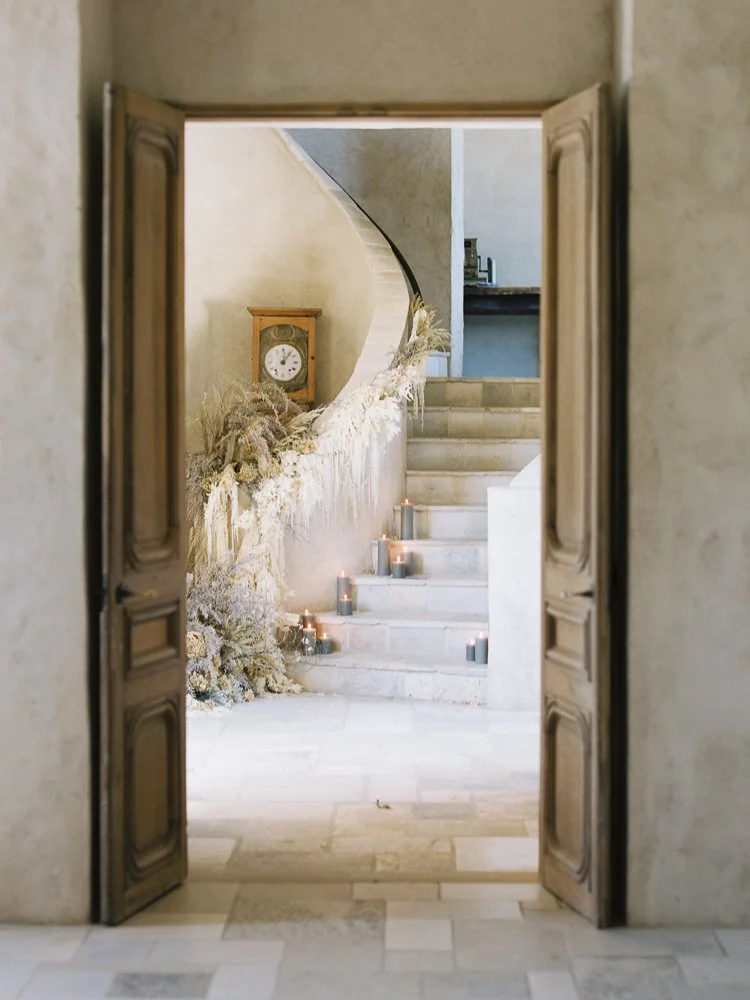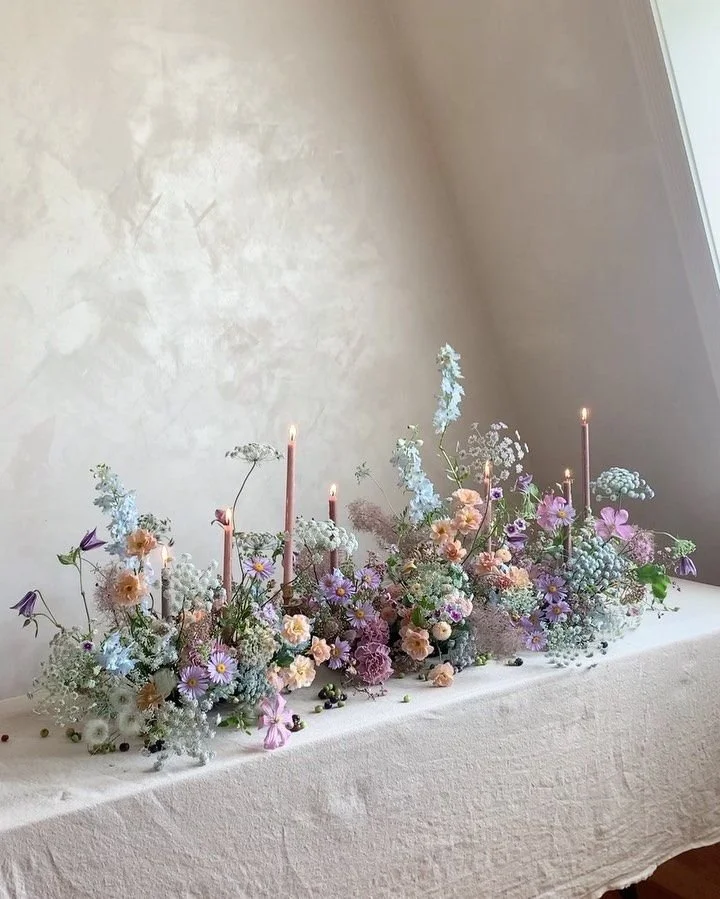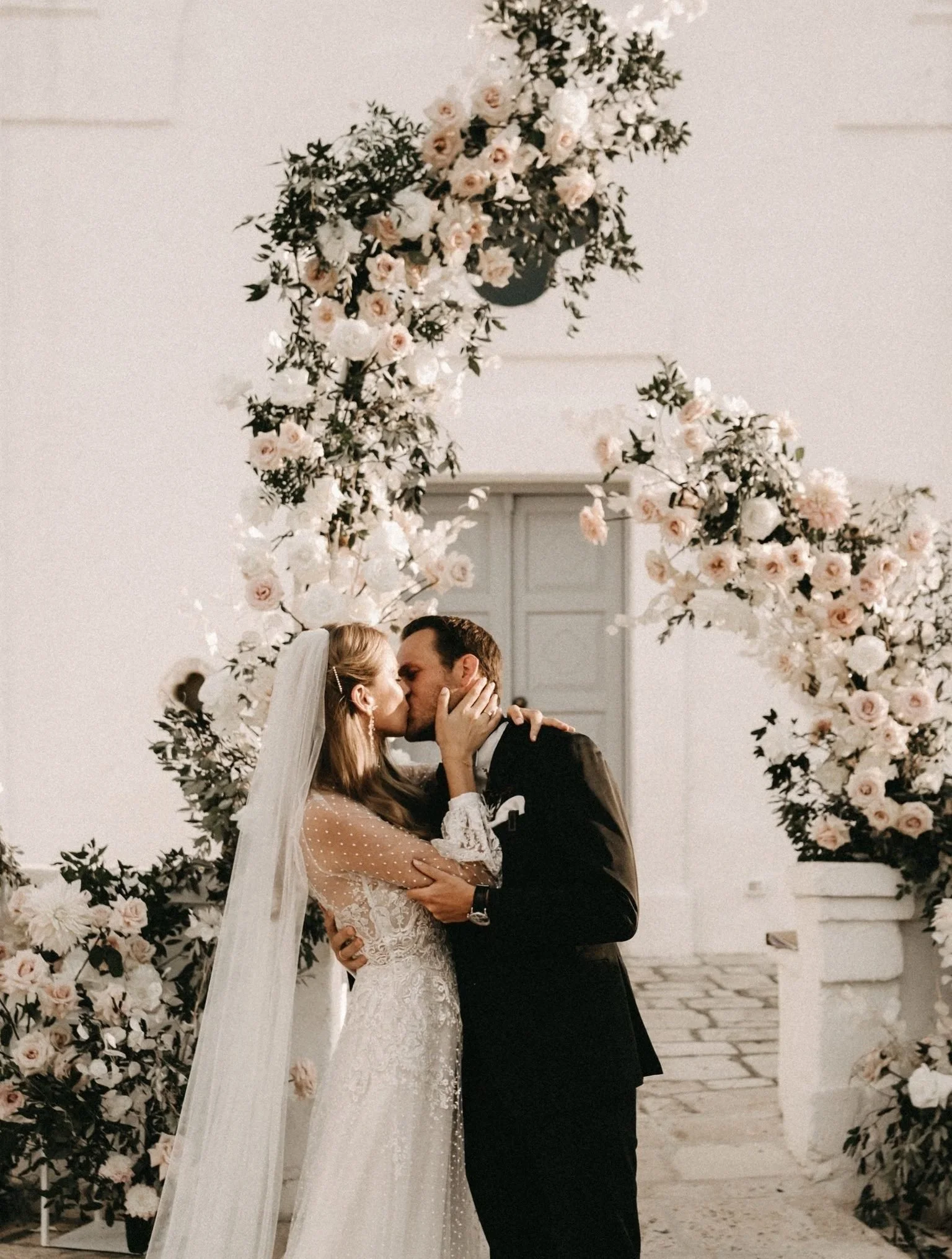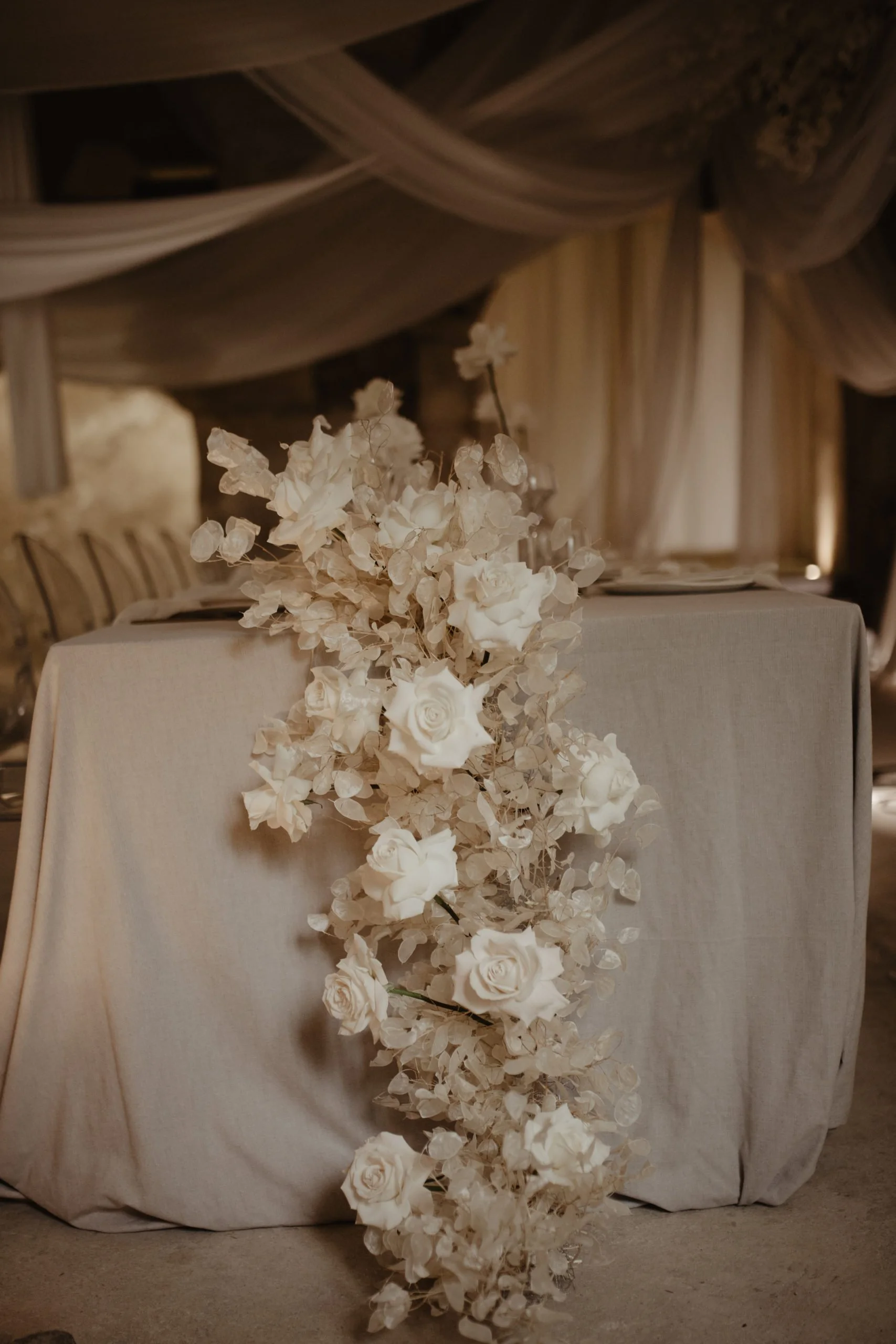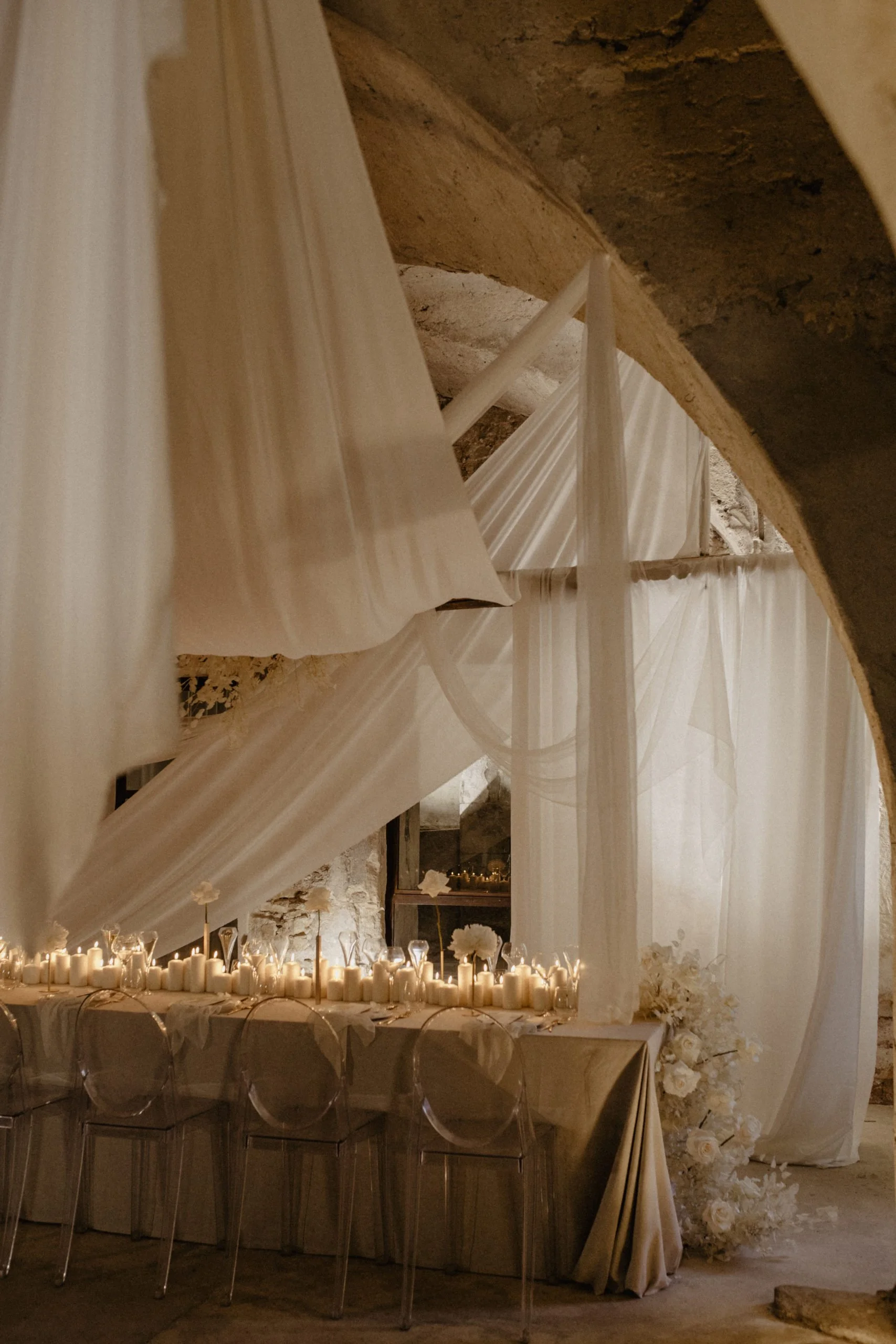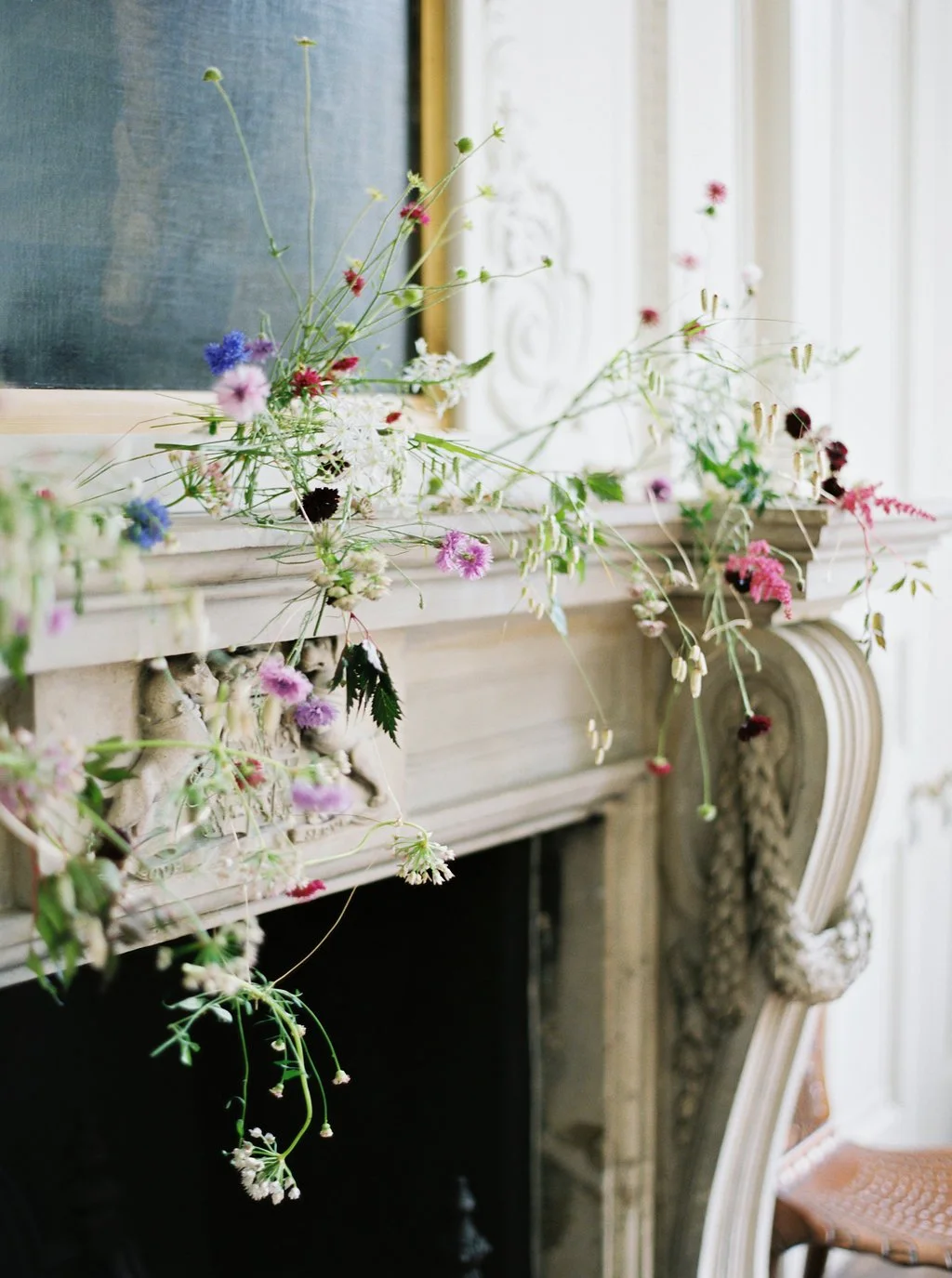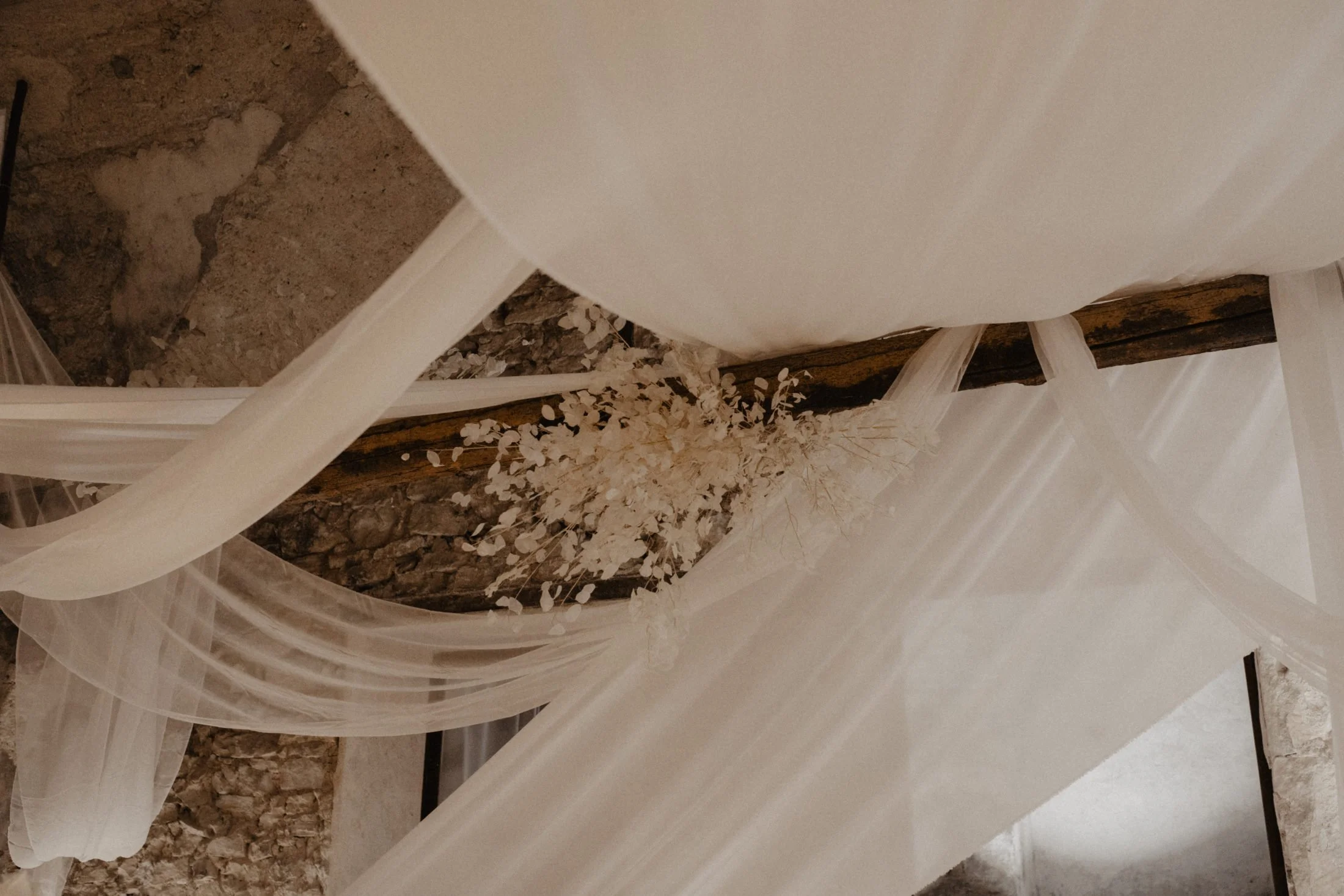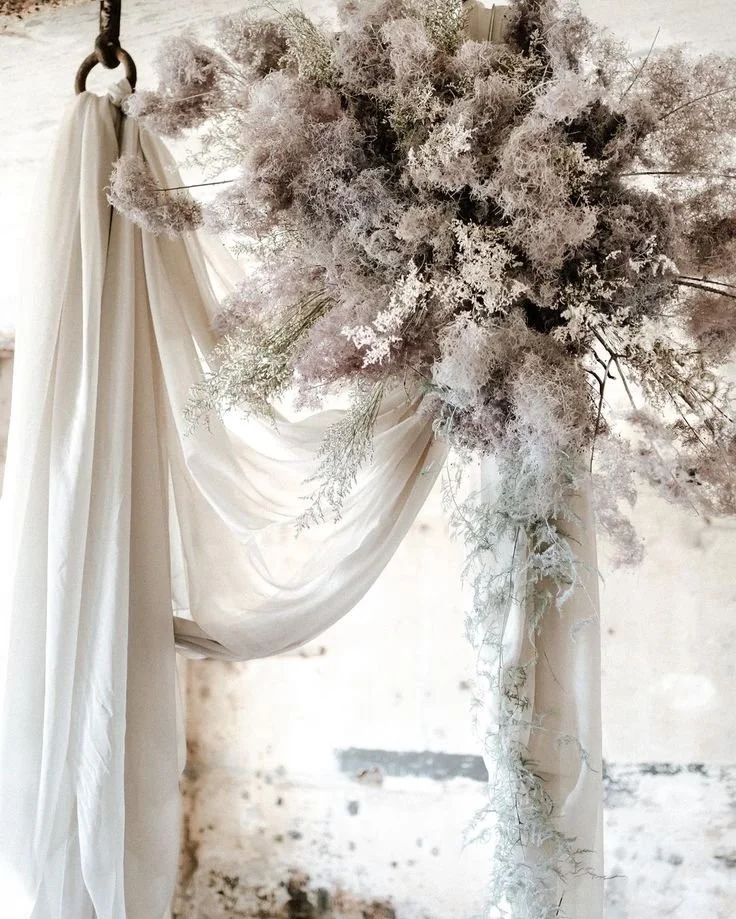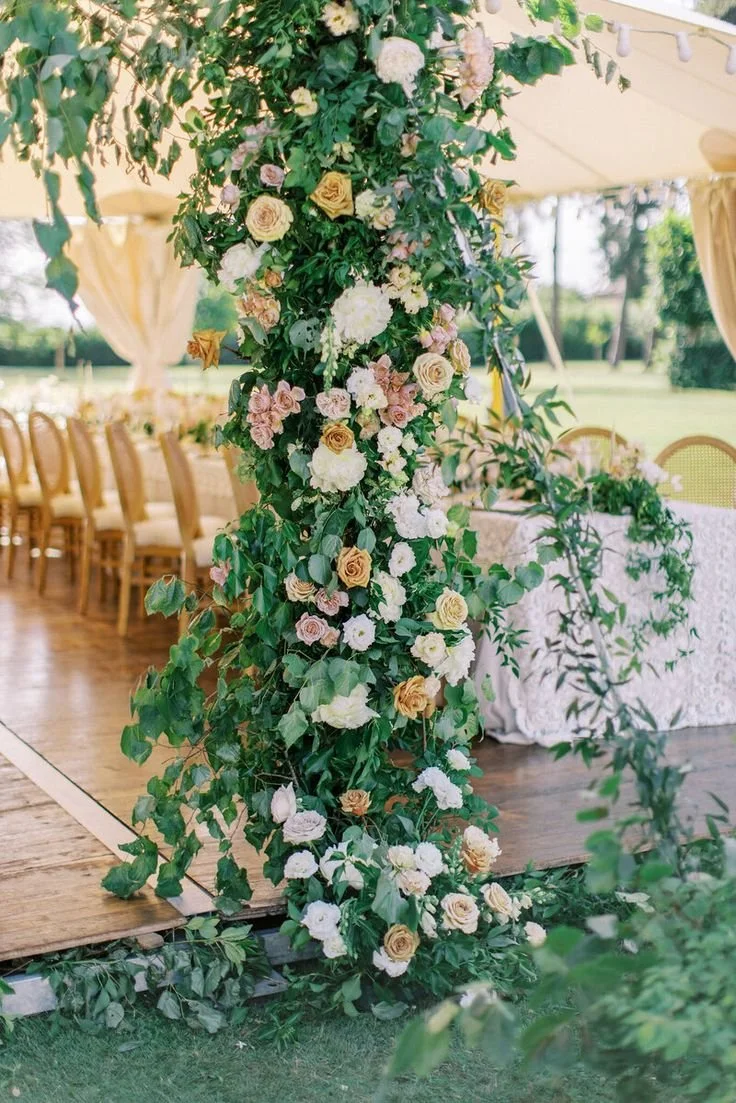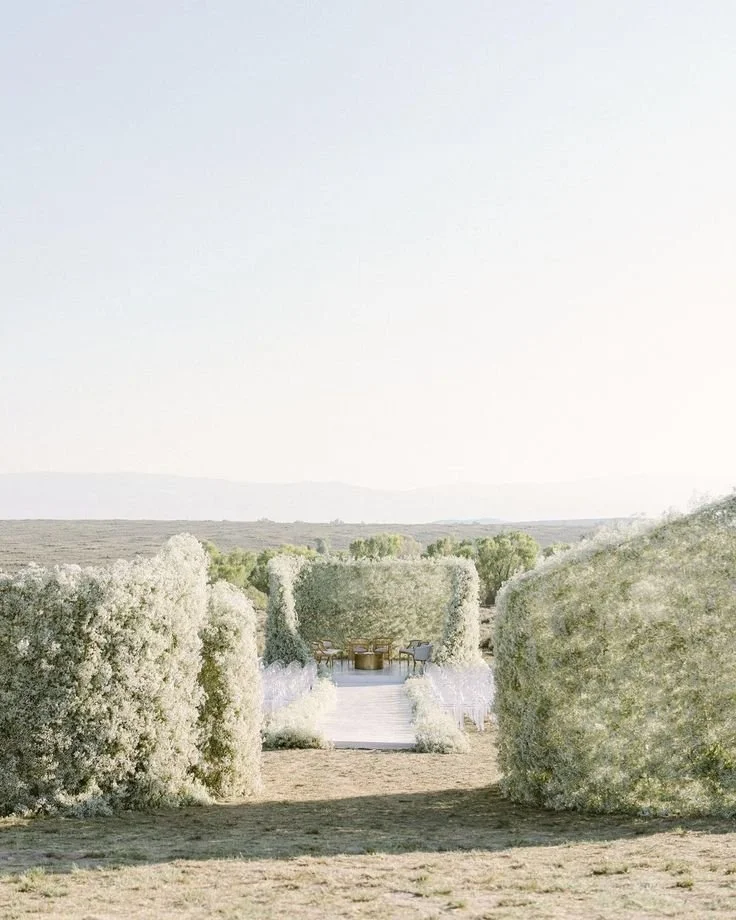The Ultimate Floral Glossary: Demystifying Every Essential Floral Term & Type of Installation
Having spent nearly a decade as a floral designer, one of the best pieces of advice I can offer couples is this: leave room in your floral budget for one outstanding installation. Give yourself clemency, even, to skip small floral pieces (like boutonnières) and let go of high-volume pieces, like arrangements for every table. Instead, dedicate your budget to an exquisite floral installation. Encourage your floral designer to create a masterpiece of beauty that translates the very essence of your wedding design. Guests will return to this piece of artwork, remember it, talk about it. A piece like this promotes conversation, and it inspires memories, reveries, dreams. It does so much more than twelve boutonnières or fifty small arrangements can. When expertly executed, a floral installation can embody the very heart of a wedding’s design.
But how to choose which installation is best for your event? After all, one of the great difficulties in floral planning lies simply in understanding the language and options available to you. Not only the lexicon is important, but what does each piece symbolize? What kind of mood does it create? What artistic feelings does it evoke, and which setting or style does it belong to?
This floral glossary endeavors to answer all these basic questions, as well as artistically depict the most beautiful floral installations. Use it to get comfortable with common floral terms. And use it to feel each piece, grasp each meaning. Ultimately, your floral designer is the artist who will bring this piece to life, interpreting you in the way that only she can, investing each form with her personal touch. Therefore, treat this floral glossary—comprehensive though it may be-- merely as a starting point, and trust your floral artist to make the concept real and personal to you.
Aisle Meadow
This installation captures the intimacy and peacefulness of walking fields, hand-in-hand, at dusk. For me, the essential beauty of the meadow is found in its grasses: the way the grasses dance on the wind, full of freedom of movement. And then there is their ability to catch light. Just stand at the field during dusk and see the tips tinged with gold (and, if you’re me, begin to mentally play Eva Cassidy’s “Fields of Gold.”). Meadows seem to be designed for a kind of human experience—for walking through them or lying in their grasses; places for daydreaming, praying, and resting. When we see a meadow, we naturally think of the metaphors of our life path and where it leads.
Meadow installations line either side of the aisle, culminating at the altar. A talented floral designer will create an aisle installation with some combination of grasses that sort of veil the flowers within them. These designs will move and dance and feel loose and organic. Flowers are often tall, leggy blooms like those we find on a nature walk—Queen Anne’s lace, angelica, meadowsweet, wild roses, daisies, asters, mint, beebalm, butterfly weed. Above all, a successful aisle meadow treatment emulates the relaxed beauty and freedom of a wild meadow.
Florals | Studio Mondine
Some “meadow” installations don’t resemble real meadows at all in terms of floral ingredients and palettes. These are artistic interpretations of the concept, not literal translations, and include flowers you would never see in a meadow, like cultivated garden roses and peonies. Often pavé and flower-forward, this aisle treatment is chock full of focal flowers (and therefore quite expensive). This interpretation is more about being showy and dazzling than organic and natural. Airy aisles of baby’s breath, meanwhile, create an image of a bride walking through clouds.
Left to right: Vogue, Molist Floristes for The Lane
As you reflect on what kind of installation you want to create, consider the attractions of the meadow with these words from designer John Greenlee, in an excerpt from The American Meadow Garden:
“Meadows are about sky and light; each is an open invitation to lie back in the grass and watch the clouds overhead. Watch the light change, and watch the grasses changing with it: no other plants can catch light quite like grasses. In early and late light, the translucent leaves of grass even take on the dramatic colored light shows of dawn and sunset. Clouds and fog are part of the meadow, too. Beads of dew and shadows of moving clouds on waving grasses are all part of the meadow. For me, meadows are all about being in them—you can design them with well-planned paths that meander through lush growth… Meadows can be secret places, tucked away in dense woodland or steep canyon; such damp, shaded, ferny meadows have a special feeling all their own. Alpine meadows are places to rest, draw your breath, and admire the beauty and grandeur of nature all around you. Meadows do not have to be expansive—they can be small, like perfect little jewels.”
2. Ceremony Urns
Stately and dignified, ceremony urns evoke a sense of tradition and Classical beauty. We mentally associate them with formal gardens filled with topiaries and Roman fountains. Ceremony urns are often placed in pairs at the front of a church or act as the crescendo at the end of an aisle—particularly an aisle installation like the one described at the beginning of this list.
Florals | Floraison Paris
Also lovely are garden-style arrangements styled on plinth bases. It’s wonderful to see flowers in conversation with Classical elements, which gives florals a sense of grandeur and importance.
Photos | Top left to bottom right: Brynna Levine, Studio Mary Lennox, FridaKim Flowers, Edénique Floral Design
3. Arches
Easily the most recognizable floral installation, arches create a canopy of flowers that shelter bride and groom and create visual poetry for the exchanging of vows. There are as many floral arches as there are floral artists: some arches involve dried botanicals and feel innovative, others are romantic and garden-style; some overflowing, others deliberately unfinished. I like to think of the arch as a visual marker, a moment that becomes a memory guests can return to again and again. Ceremony arches are among the most pinned, saved, and shared floral applications; their ‘wow’ factor is undeniable.
Photos, top left to bottom right | Aulling Atelier, Floraison Paris, Gather Design Company, Aulling Atelier
4. Floral Nest
Florals | Aulling Atelier
This installation often takes the shape of a semi-circle and surrounds the couple as they say their vows. The nest is a pinnacle of garden-style design, elevating the casual glamour of garden flowers into something more polished and deliberate. A nest creates this feeling of being ensconced in flowers—truly, the equivalent of a floral embrace.
Left to right | Running Wild Florals, My Violet
5. Suspended Installation
These flowers float from ceilings, tented canopies, or chandeliers. This approach reminds me so much of Renaissance ceilings, with their heavenly depictions and soft palettes. We are reminded, poignantly, that we find beauty when we turn our gaze upward, heavenward.
Left to right | Aulling Atelier, Contelier Flower
Whether treated on a chandelier form or a structure-less, floating design, suspended installations should evoke a sense of awe and wonder. We may naturally think of canopies that are chock-full of flowers, staggering in terms of the sheer amount of material used. But I often find that strands of flowers—a delicate, minimal treatment—can be most poignant of all. It all comes down to the individual designer and his or her touch.
Look to Rebecca Louise Law for the consummate expression of suspended floral art. Law creates living sculptures, and her medium just happens to be flowers. Especially moving is her work with dried materials and flowers past their supposed peak of beauty. There’s beauty in just how painstaking the work is, with every flower individually wired onto copper. A testament to art, which if it is true will always take incredible time and care.
I am captivated by those installations which create a feeling of flight. Delicate and aerial, these floating flowers seem to have just been taken by a breeze. They are particularly angelic in white or ivory— wing-like and pure.
Left to right | Artist Gabriel Orozco, Fridakim Flowers, Sarah Winward
Above all, when mapping out an installation, allow your floral designer to work with dried florals. This not only expands the range of materials and creative possibilities, it also gives your installation a much longer life—a bit of immunity from heat, cold, and other weather extremes. Beyond its practicality, dried flora is simply gorgeous: expressive, artistic, ethereal, slightly organic. There are some floral designers who are artists at heart, and so many of them prefer dried flora for its extended life and creative potential. I see no reason to insist solely on fresh flowers, which places exigent demands and undue pressure on a designer to beat weather (an almost impossible task) and to create an installation under stress, on a given day, in a matter of hours (for fresh flowers will die before then). Creativity simply does not flourish under these conditions. Dried flowers, on the other hand, rescue your designer from extreme time constraints, allowing room in the creative process for spaciousness, expansiveness, reflection, peace, and breath. When not struggling merely to keep flowers alive—when her brain is not fully devoted to the care and keeping of flowers—an artist is given back permission to create, to be an artist.
Left to right: Studio Mary Lennox, Edénique Floral Design
6. Floral Clouds
Sassafras Wedding for The Lane
These ethereal clouds belong under the category of suspended installations, but due to their popularity, deserve an individual moment here. Angelic, lilting, and simply lovely. These little clouds are usually composed of preserved or fresh baby’s breath, often (but not always) painted or tinted to add a touch of the surreal. While beautiful with just baby’s breath, the cloudlike base can also act as a foundation for heavier florals, with roses, orchids, and peony punctuating the airy arrangements.
From top left to bottom right: Aulling Atelier, Steelcut Flower Co., Aulling Atelier (three photos), Floraison Paris
7. Table Chuppah
Any Gilmore Girls fan has a soft spot in her heart for the chuppah—remember when Luke, in an act of selfless love for Lorelei, made a chuppah for her wedding to Max? *Sigh.* While beautiful for ceremonies, the concept is so unique when re-imagined as an adornment for imperial tables. Can you imagine a more exquisite dining experience, with flowers sheltering you and your loved ones? This installation is particularly uplifting with spring florals, which lend a feeling of rejoicing, like a burst of angelic song, marking the moment winter fades and spring flowers usher in God’s season of redemption, resurrection, renewal.
8. Tree Installation
If you’re marrying on a property with gorgeous, mature trees, it’s only stands to reason that you would work with what you have, draping them with flowers and allowing them their fullest expressive potential. I picture South Carolina oak trees veiled with Spanish moss and, with your designer’s help, ethereal white florals floating from their base. A naturalistic, organic take on this installation feels refreshing, as the design can often feel quite Pinterest-y and predictable. Embrace dried flowers, unique specimens, and vining material along with classic wedding blooms.
Left to right: Faye and Renee, The Petal Report
9. Imperial Table
An imperial table is simply a guest table, dramatically extended for maximum visual interest. This is a particularly stunning concept for micro weddings with a very small guest list (20-40, perhaps) or a beautiful way to seat a bridal party where a larger wedding guest list is concerned. These tables look breathtaking when they are placed in a vast setting: a forest, a desert, a garden pathway, anywhere blessed with natural beauty. There’s something so storybook about walking up on a table in the woods, as though fairies had set it for you. And there’s a pleasing jolt of irony when one finds this exquisite, formal table in a seemingly incongruous setting, like a wild desert. Explore a curving, undulating table design that allows for extended floral arrangements, like a floral pathway or meadow for the table. Simple and stark arrangements work well for naturalistic settings, and lush, overabundant floral garlands or compotes elevate the already extravagant beauty of an English garden. These long tables also invite artistic explorations, like color gradation, which works effectively on a large scale.
Tabea Maria-Lisa for the Lane
10. Harlow Stands & Pedestal Arrangements
The Harlow is a slim, usually brass, pedestal, that houses florals. The Harlow can be a vessel for a design that’s typical in shape, with flowers arranged on top. The wonder of this is the seeming improbability of it, as it provokes viewers to ask, how did they create the flowers on that? Designers can also weave flowers onto the legs of the stand, creating climbing or cascading designs of flowers and vines. I love this more organic approach as it evokes the beauty of climbing roses on a trellis, giving the Harlow a kind of garden authenticity, and rescuing the design from any kind of Pinterest-ready aesthetic.
Left to right: Betty Flowers Santorini, The Petal Project
Similar in concept, pedestal arrangements give flowers a sense of grandeur, a museum-worthy feeling. Sculptural flowers and interesting branches, when displayed on a pedestal, look like an artist’s display— a piece created for exhibition.
Left to right: Ruby Mary Lennox, Fridakim Flowers
11. Acrylic Arrangements
Acrylic stand arrangement works beautifully for modern ceremonies, especially when paired with Lucite chairs and shimmering glassware. Flowers housed within acrylic cases look modern and somehow moving— as though they’ve been frozen in time (these arrangements always somehow remind me of the rose on Beauty & the Beast). Dried flowers work especially well in this glass house concept, as they are able to withstand the water-free environment, and are simply beautiful to look at— ethereal, otherworldly. Emphasize the acrylic effect with flowers in iridiscent hues, like opalescent lunaria seedpods and shimmery, painted fern.
11. Still Life
Inspired by artists from the Dutch Golden era of painting, some of the most talented floral designers turn to the still life motif to showcase flowers in their most painterly light. Under this approach, a table or a floral arrangement becomes a portrait-like experience. Linens, candelabras, vessels, and seasonal fruits create a visual story around Dutch Masters-style flowers, which are always lush and abundant. Imagine late autumn roses paired with seasonal fruits—jeweled pomegranates, dates, currants, passionfruit, and figs; the last and sweetest gems of the harvest. Or picture a spring table bathed in pink and apricot hues, with fully unfurled peonies, bearded iris, and bleeding-heart vines, layered with crystalware and golden currants. The still life offers an intelligent and artistic approach to florals, steeped in tradition and rich with historical references. And its evocative fruits and flowers delight all the senses, inviting viewers into an immersive encounter with beauty.
12. Floral Table
Inspired by the exquisitely talented Floraison Paris, imagine a table entirely bedecked with flowers. Pieces like these create a sense of wonder—they are more reverie than real life, and therein lies their beauty. While you’re at it, ask your floral designer to create a pair of floral chairs—why not?—to really create an enchanting table pour deux.
Left to right: Floraison Paris, Aulling Atelier
13. Staircase Installation
So many of the most iconic movies (especially those with a makeover scene!) involve a staircase moment. There’s something about appearing at the top of a staircase that really makes the transformation complete—that gives the ‘reveal’ moment the grandeur it deserves. The ultimate: Eliza Doolittle appearing in an ivory beaded Givenchy gown with opera gloves, looking as exquisite as any woman ever has. But there are so many more—Rose in Titanic, Annie in The Princess Diaries, and the list goes on. The motif is enduring—a woman appearing in evening wear, her beloved at the bottom of the staircase, mouth agape over her beauty.
Weddings, obvi, are the perfect moment to embrace the movie magic. Render your groom speechless as you descend a flight of stairs this glorious, with flowers whose beauty are surpassed only by yours on your wedding day.
Courtesy of Loho Bride
14. Table Meadow
Just as meadow pathways are beautiful for ceremony aisles, they are equally delightful when scaled down and reimagined for a table. Rather than housing flowers in vases, allow your designer to work vessel-free, exploring the freedom of movement of flowers in meadows and in wild nature. Like a wild meadow, this table meadow should draw the eye upwards, with tall, floating flora, and back down, to flowers that caress the table. These free-flowing designs add something unexpected, honest, and utterly beautiful to guest tables, infusing a predictable motif with surprising grace, and a touch of wildness.
15. Door Installations
This installation, when expertly executed, has a storybook magic. What could be more enchanting than walking up on a door framed—no, laden—with flora? This design has crossed over effortlessly into the fashion world, and it is little wonder why. From Love Shack Fancy’s cottage core storefronts to London’s exquisite boutiques, fashion’s finest flagships love to drape their doors in flowers. The artistic excellence of the Chelsea Flower Show meets the surprise and delight of an illustrated storybook, all in one charming design. When creating my Chapel Journal venue painting with artist Emily Mayne, I knew I wanted the spring version to include pastel flowers framing the chapel’s doors. The image is so poignant, so pure— a little church all dressed up for spring.
For weddings, door installations tend to be quite grand. Many modern royals opt for this design, as it creates an unforgettable backdrop for photos and creates a thrilling sense of anticipation. What better way to create a grand entrance—and an exit for the ages?
Nina e i Fiori, Faye and Renee
16. Flowers designed to enhance architecture
Flowers have such potential to complement and reveal the beauties and virtues of architecture. Flowers can follow the softly flowing curves of arched doorways or curl around Classical columns. They can highlight the most dazzling aspects of a space, drawing the eye upward to heavenly ceilings, or rippling down a grand staircase. No other aspect of décor can as effortlessly conform to a space’s lines, shapes, and its architectural features. And yet it’s more than that: flowers have such expressive potential; they are apt to embody the overall atmosphere, mood, or aura of a given space.
Fashion-forward flowers, like painted and dried botanicals, create an interesting juxtaposition when used in conversation with crumbling stone, ancient facades, or gracefully aged, plastered walls. Florals need not be demure: they can meet with spaces in a way that creates a spark, a frisson of excitement. When unexpected floral choices are used in ancient settings, the effect can be almost museum-worthy— like something created for an exhibit or couture runway collection. Of course, flowers need not be controversial to thrill or move us deeply. Imagine a chapel filled with the most delicate, angelic flora— little creations that seem spun by angels. Flowers often have the greatest power over us when they simply look and feel sweet, like a dream. Even when they are quiet, flowers give something to a space (and to a viewer) that’s difficult to describe— something intangible, but undeniable.
Ruby Mary Lennox, Showroom by Maja Starek
17. Floral Garland
When the word ‘garland’ is mentioned, one naturally imagines evergreens adorning Christmas mantels, staircases, and columns. But in recent years, designers have embraced a flower-forward take on the motif, especially for reception tabletops. These luxe garlands are often created without a speck of foliage and instead utilize hydrangea, peony, and garden roses. The chock-full-of-flowers garland is particularly popular in tented receptions, and often in wedding designs that favor “face” flowers (the common term for full and fluffy flowers). For a refreshing take on the floral garland, pair pure white garden roses with iridescent, dried lunaria. The garlands below are, to my eye, perfectly and exquisitely executed— at once subtle, surprising, elegant, and intelligent. Lunaria shimmers and refracts light so beautifully, like an opal or a moonstone does. How beautiful it is to see a designer work with the use of light, pairing opalescent flowers with a lavish amount of candlelight, and therein creating layers upon layers of lustrousness.
18. Mantel Arrangements
For the most Downton Abbey-esque approach to design, adorn an historic or ornate mantel with graceful flowers. One of the great pleasures of watching a period-style film or series is simply taking in the set design, seeing the thoughtful floral arrangements that grace each each dinner table and beautify fireplace mantels, lending a room a quiet ambience. Flowers like these transport us to the days when courtships were conducted in the language of flowers, and a lady could receive a new bouquet first thing each morning, each flower symbolizing a secret feeling, a deepening of love (fragrant paperwhite for chivalry and admiration; violets for secret, thrilling affection; and at last, roses, for love). Mantel florals exude such Victorian-era grace, reminiscent of the work of early masters like Constance Spry. Unexpected materials, like smoke bush, seedpods, and dried flowers, give mantel flowers a certain modernity, while English garden flowers are the classic choice.
19. Concealing florals
Charlotte Flower and Twig, Mrs Gibbons Flowers
When something in your event design needs concealing, turn to flowers. Tent poles, curtain-tie backs, staircase railing can easily be beautified with intelligent floral placement. Beyond this, it’s wonderful to embrace flowers as more than a corrective and instead embrace their transformative beauty. Many drawbacks can, under a well-executed floral design plan, become a surprising highlight.
20. Floral Chandelier
Few things pair quite as naturally as florals and chandeliers. Designers can add florals to an existing fixture (with some limitations) but often prefer to create a new structure designed expressly for the flowers, style, and setting. At any rate, the floral chandelier has the potential to become an event’s most talked-about, photographed, and Instagrammable feature.
Floral chandeliers work wonderfully in white sailcloth tents, whose very style and layout asks for visual interest around the ceiling area. They’re also chic when suspended above a reception table; this is especially true when the chandeliers draw the eye to a certain backdrop, like the terra-cotta-tinged pink walls of the Palm Springs resort pictured below. This funky-fresh little collection reminds us that, when it comes to floral chandeliers, the scale doesn’t need to be grand; maximum style can be created with a minimal touch.
21. Bespoke Concept
Above all, don’t feel limited by this list. To the contrary, bring an open mind to your floral designer, trusting in her unique artistry and touch with flowers. Nothing could be more personal than creating a piece just for you—the floral equivalent of a one-of-a-kind wedding dress or custom, hand-painted stationery. Floral designers are, by and large, some of the most visionary artists in the wedding space-- and beyond. Placing trust in them unlocks the magic, the flow, and encourages flowers to appear their most beautiful. Trust is everything, everything to the process. It only stands to reason that the most exquisite piece is the one dreamed up by your floral artist, expressly for you. Looking to nature and to the uniqueness of each flower, look beyond the screen and beyond what has been created before to what can be created now, in this moment, with these flowers, for you.

